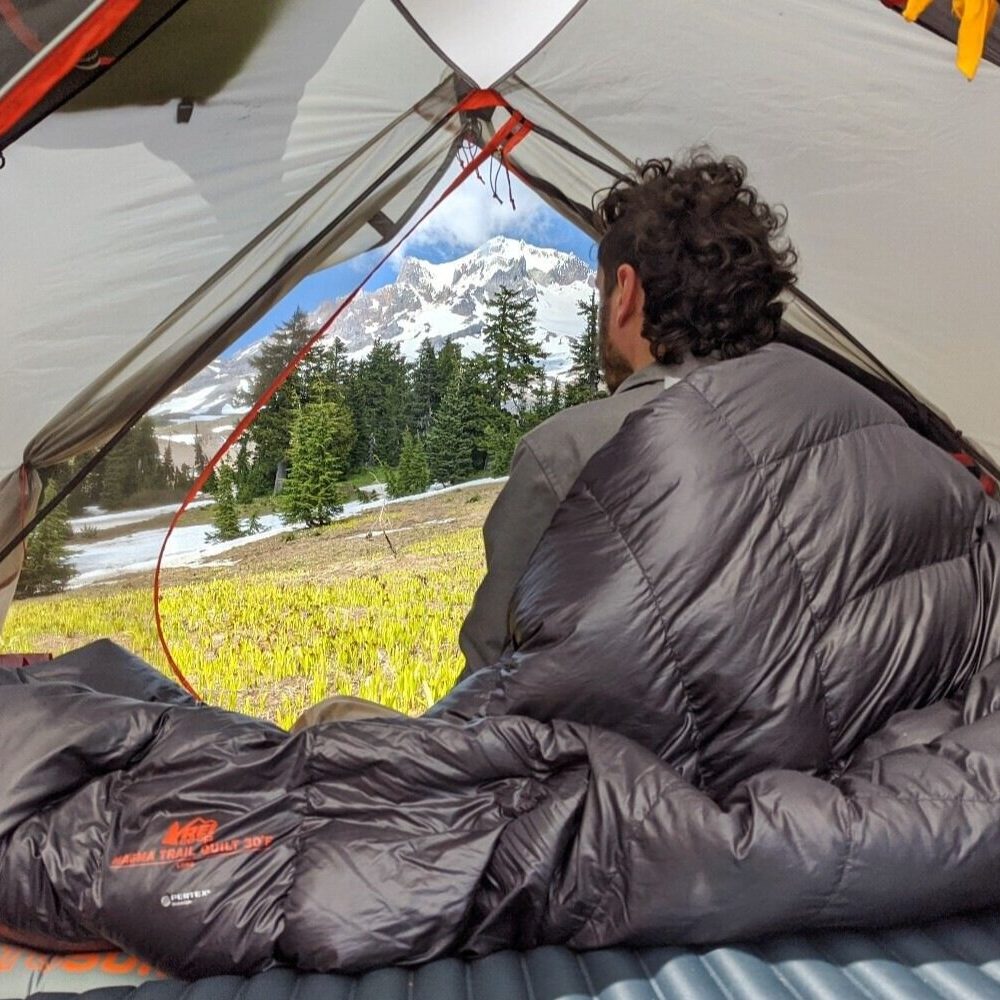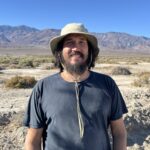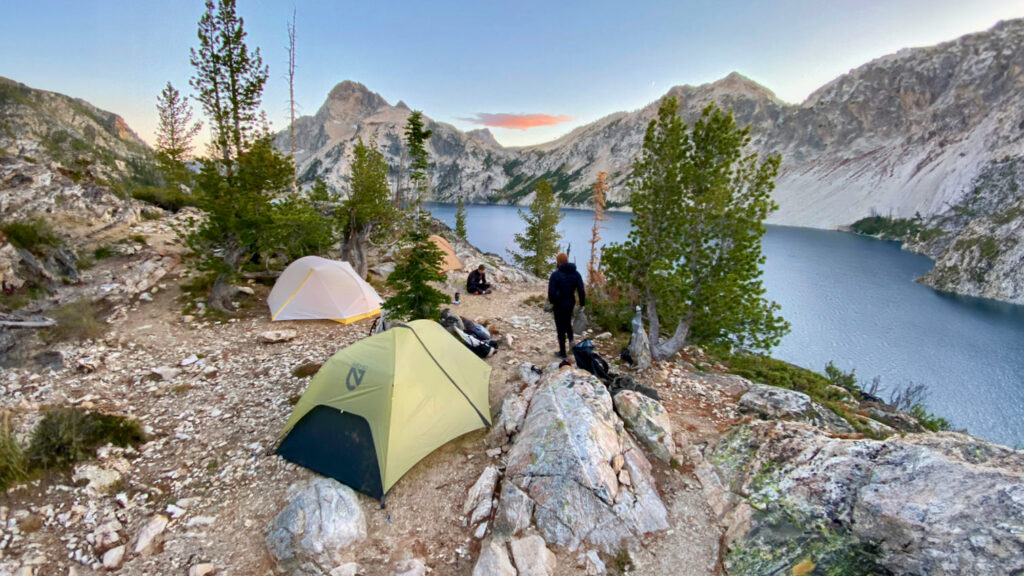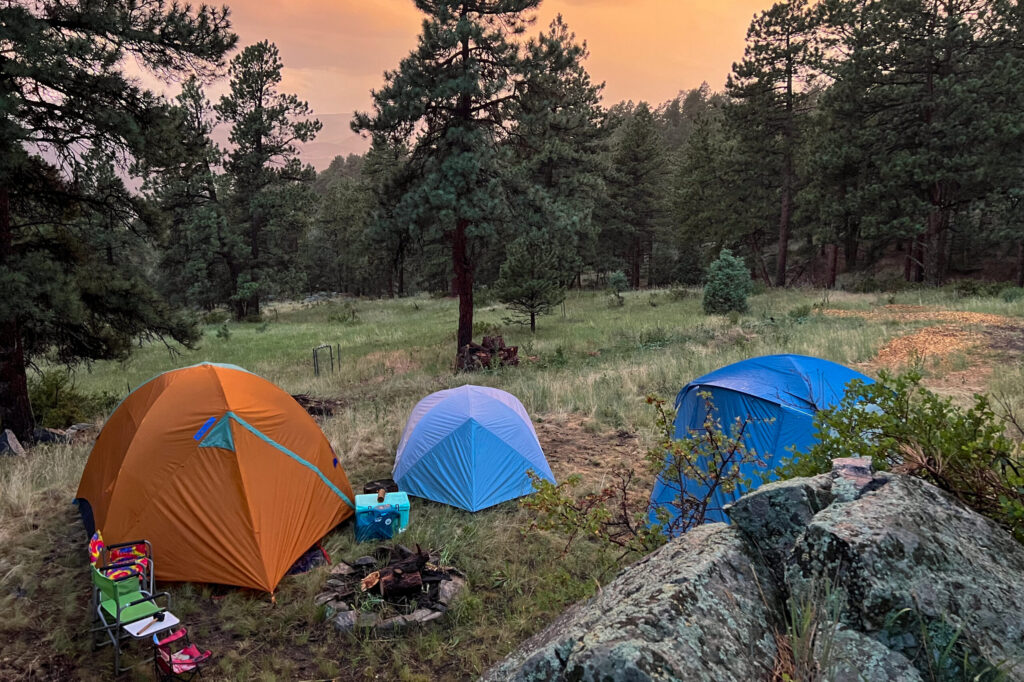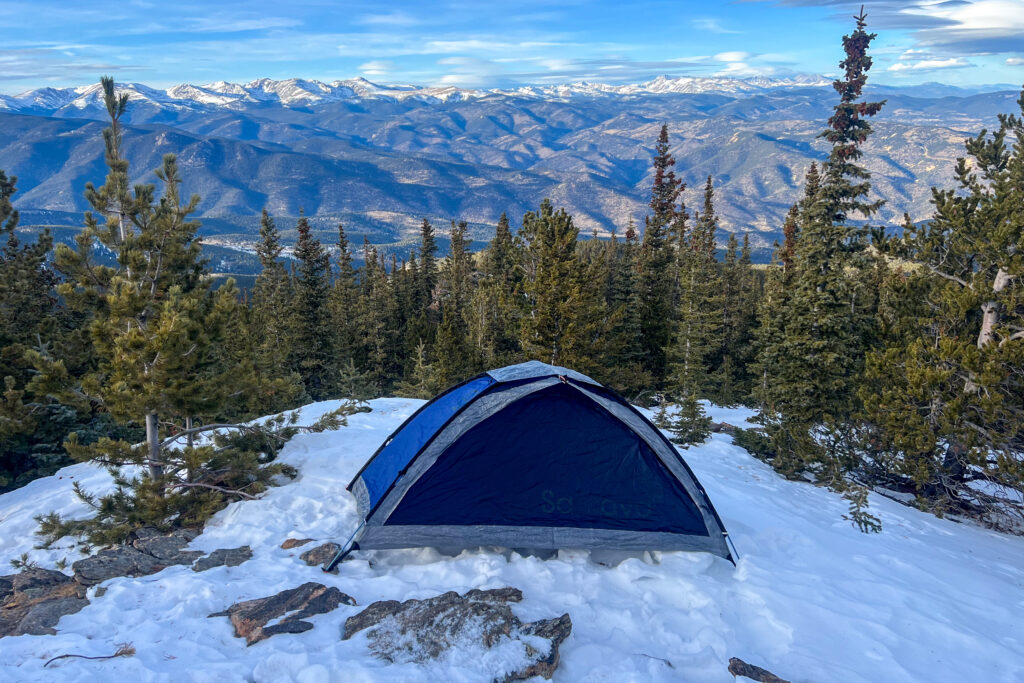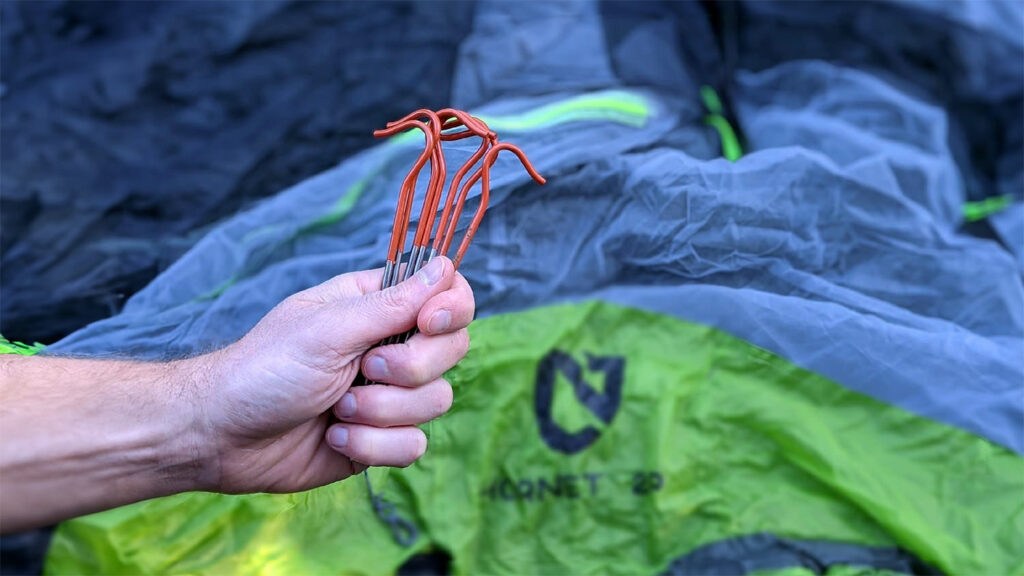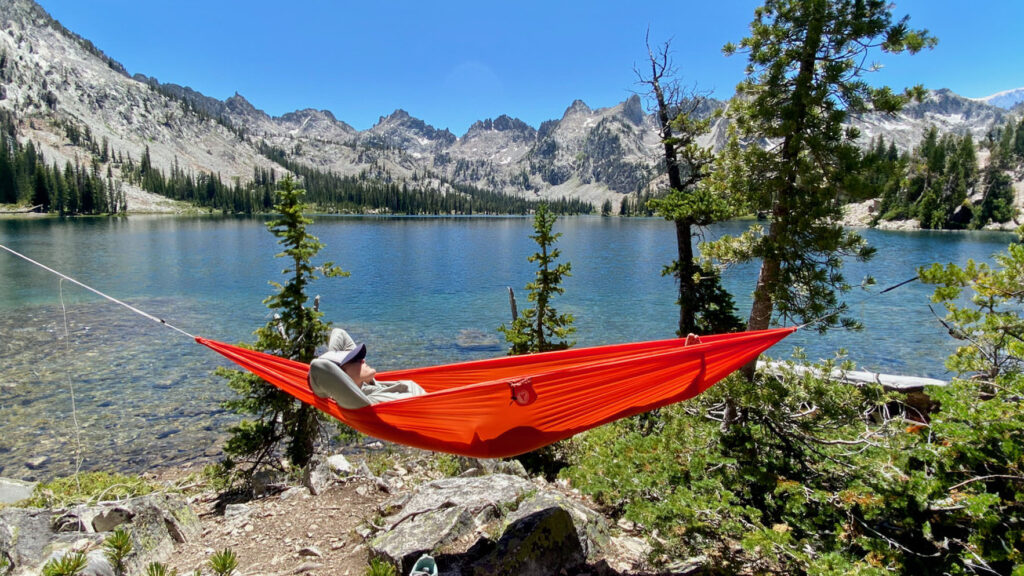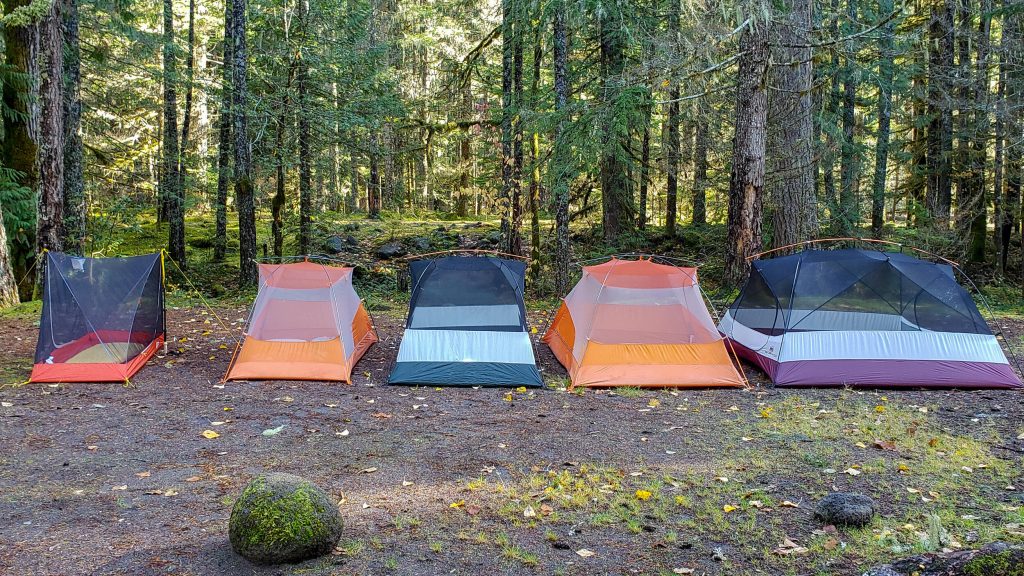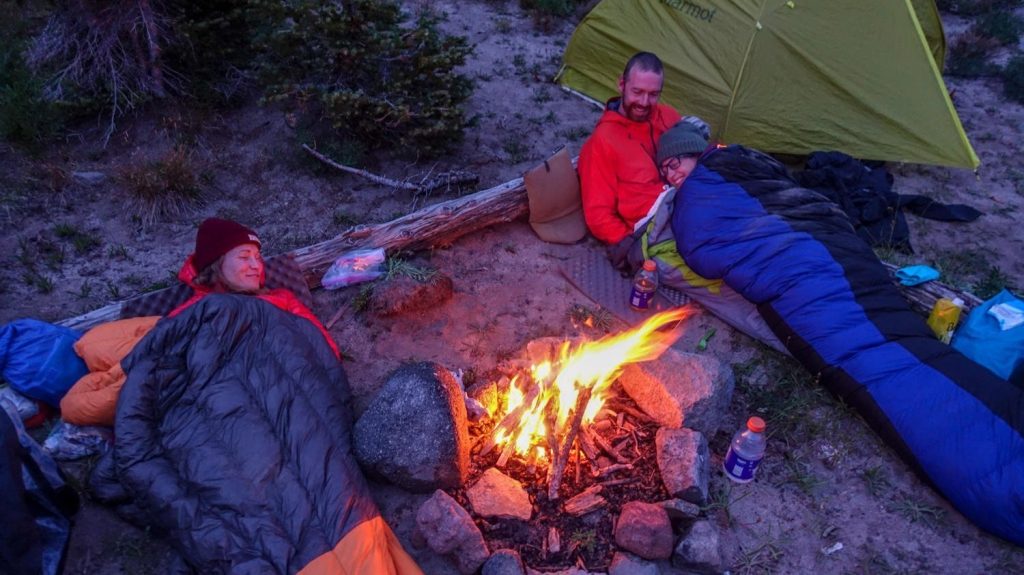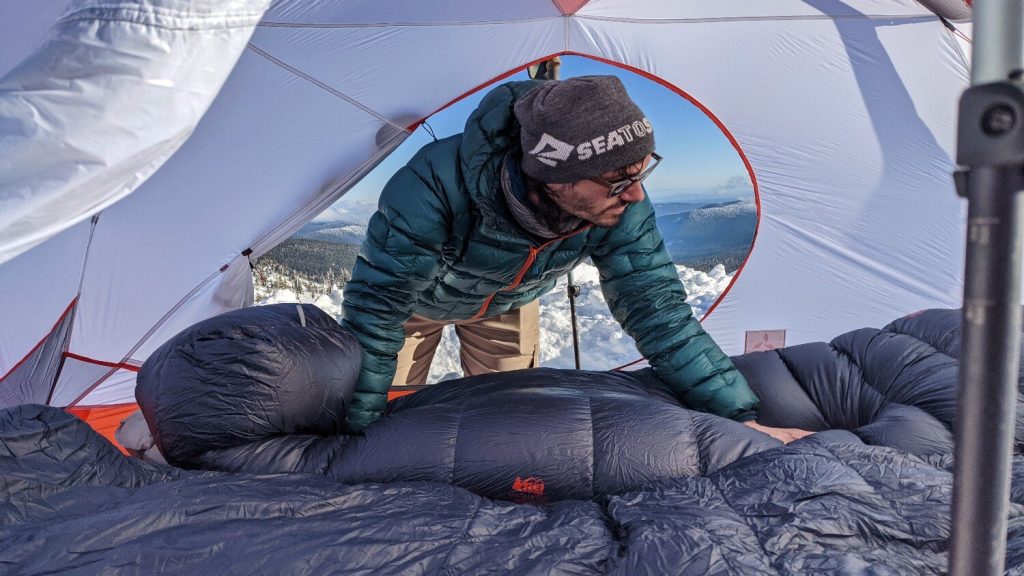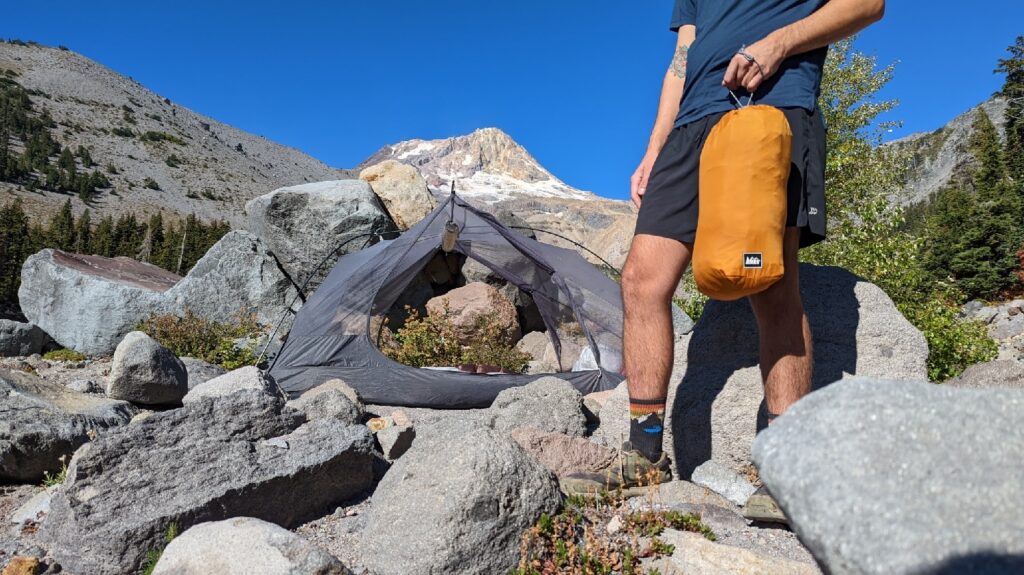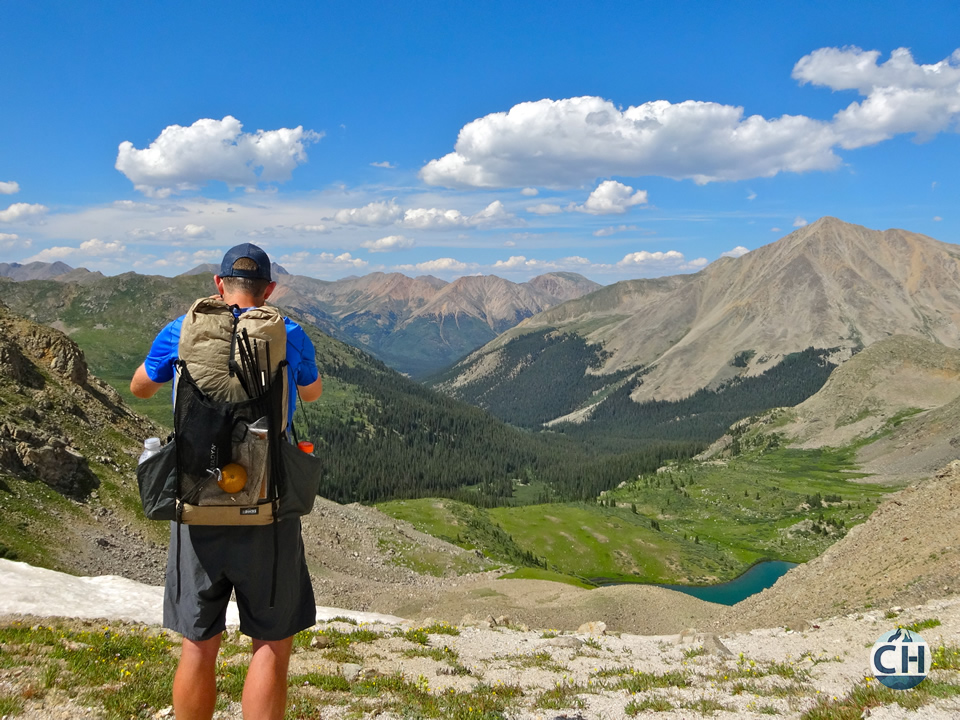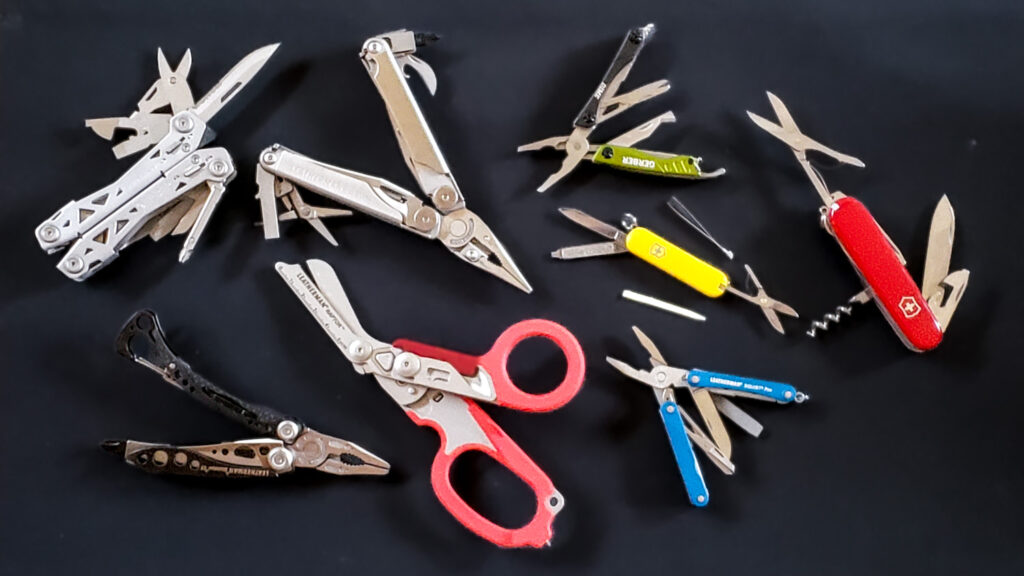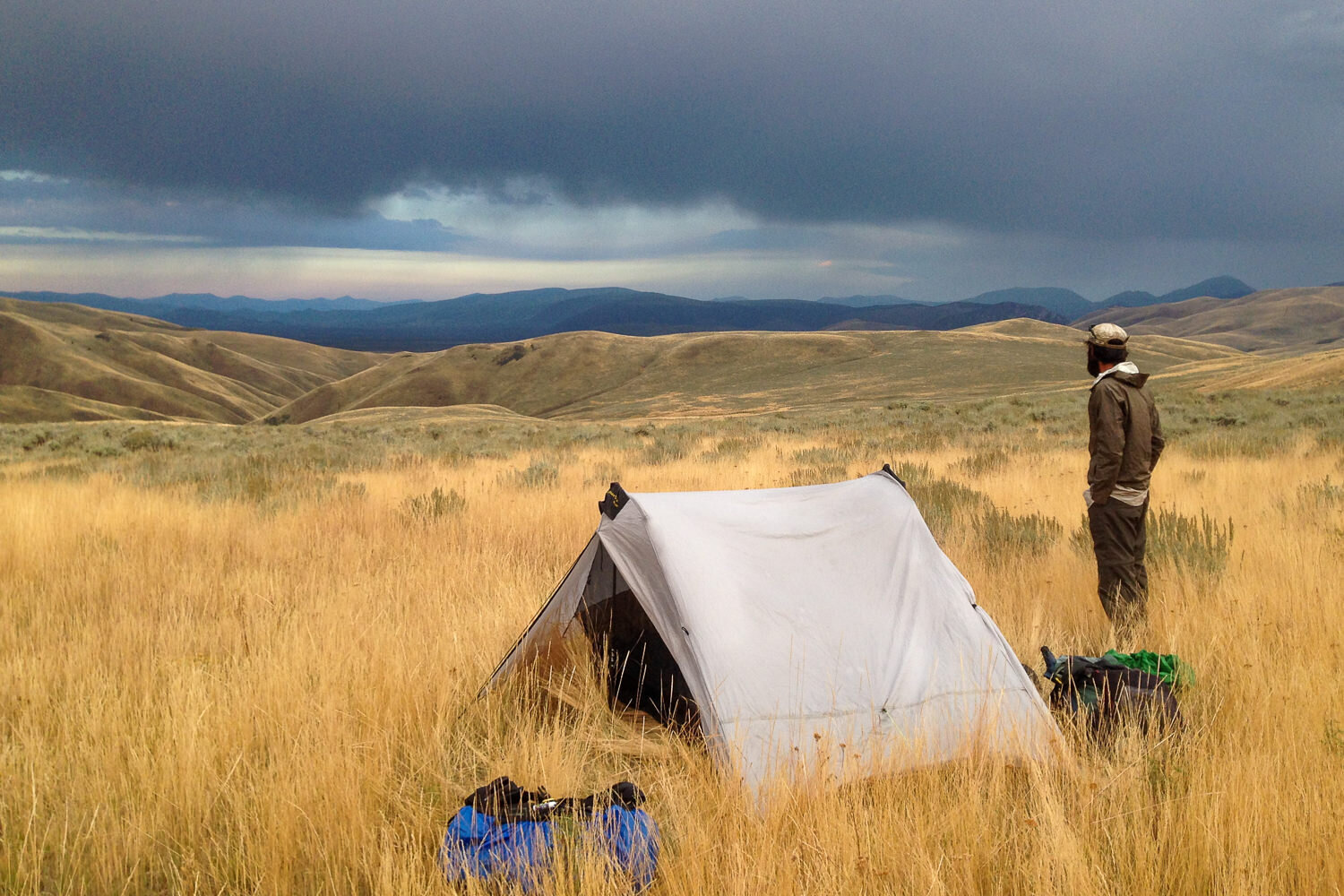
With so many different options when it comes to purchasing tents, it may be overwhelming to decide which style is best suited for your needs. That’s why our gear analysts diligently examined and thoroughly researched over 40 different models of the most popular tents before narrowing it down to the most promising for hands-on testing in terms of affordability, comfort, weather resistance, durability, portability, and ease of use.
From well-known brands like REI, Coleman, and Kelty to more specialized cottage companies such as Tarptent and Six Moon Designs, we’ve rigorously trail-tested our collection of the top budget tents on the market to help you decide the best fit for you. Camping in areas such as the Los Padres National Forest, the high desert of the Eastern Sierras, and California’s coastal Santa Monica Mountain Range, our lineup was methodically tested in the field to bring you our list of the best.
And for more info, check out some of our other popular gear guides:
Quick Picks for Budget Backpacking Tents
Browse our top picks below, or continue scrolling to see our full list with detailed reviews and analysis.
Best Budget Tent Overall: Tarptent Stratospire 2 ($259)
Best Budget Backpacking Tent: Six Moon Designs Skyscape Scout ($160)
Most Spacious Backpacking Tent: Six Moon Designs Lunar Duo Outfitter ($210)
Best Crossover Tent: REI Half Dome SL2+ ($259)
Best Budget Tent for Pocket Storage: Mountainsmith Morrison EVO 2 ($230)
Fastest Setup Tent: Kelty Late Start 2 ($160)
Most Livable Interior Space: Marmot Tungsten 2 ($249)
Most Well-Rounded Features: REI Trail Hut 2 ($229)
Lightest Freestanding Tent: Naturehike Cloudup 2 ($170)
Best Modern Update with Great Stargazing: Coleman Peak 1 ($270)
Most Affordable Budget Tent: Clostnature Polaris 2 ($80)
What’s New
After considerable market research looking at and comparing new tent models, then deciding which ones to rigorously field test, we’ve added a minor update to a previous version from Mountainsmith.
- The Mountainsmith Morrison EVO 2 is the updated tent version built from their popular Morrison 2 model. It now includes a brow pole and increased interior volume and livable space.
Budget Tents Overall Testing Scores
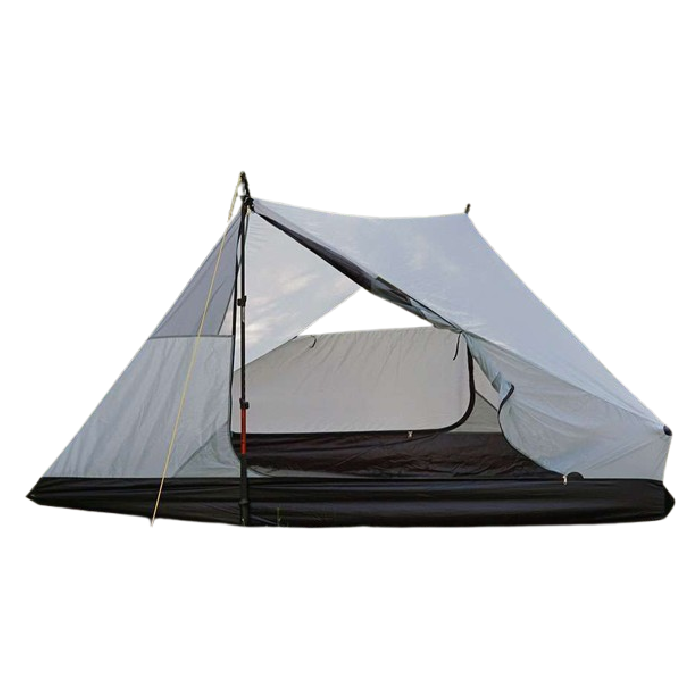
Tarptent Stratospire 2
Best Budget Tent Overall
CleverHiker Rating: 4.8/5.0
Price: $259
Dimensions (LxWxH): 7.2 x 4.3 x 4 – 31.1 sq ft
Weight: 2 lb. 11 oz.
Type: Freestanding
Pros
- Stable in the wind
- Ultralight and packs down well
- Durable
- Ample headroom
- Good ventilation
- Quality materials
Cons
- Requires practice setting up
- Thinner materials need more care and attention
The Tarptent Stratospire 2 stands out as a remarkable non-freestanding shelter, prioritizing a lightweight design, spacious interior comfort, and adaptability for variable conditions. Its ultra-lightweight configurations, achieved through optional mesh interiors and fly, cater to the most weight-conscious backpackers. Premium, yet durable materials compress exceptionally well for minimal pack space. The Stratospire 2 truly shines with its interior volume, boasting an impressive 4 foot peak height with ample headroom for taller individuals – a rarity in non-freestanding tents.
The tent’s unique low hexagonal shape minimizes wind drag, with help from the small panels and balanced tension lines. The innovative, removable pitch-lock vents reduce airflow and maximize stability in blustery conditions. When staked out, each anchor point has adjustable tension straps to make everything even more taut. Adding to its value, the Stratospire 2 includes six high-quality Easton Nano 9” nail-style aluminum stakes, ensuring a secure pitch – unlike other backpacking shelters in this sub-category. These features, combined with optional add-ons like the SideCar for children or pets and trekking pole adapters for boosted space, make the Stratospire 2 a highly adaptable and well-designed backpacking shelter.
Despite its many advantages, the Stratospire 2 isn’t without its drawbacks. As a non-freestanding tent, it requires practice and a more nuanced understanding of pitching techniques compared to simpler freestanding dome tents. Furthermore, the use of thinner lightweight materials, while contributing to the tent’s low weight, necessitates greater care and attention, especially in rough terrain or areas with sharp vegetation.
Tarptent Stratospire 2 is a superb investment for weight-conscious backpackers seeking a spacious, versatile, and highly capable non-freestanding shelter. Its unique features, premium materials, and thoughtful design make it stand out in the backpacking tent sub-category. Those who prioritize low weight and adaptability, and who aren’t intimidated by a slightly more involved setup process, will find the Stratospire 2 an exceptional choice.
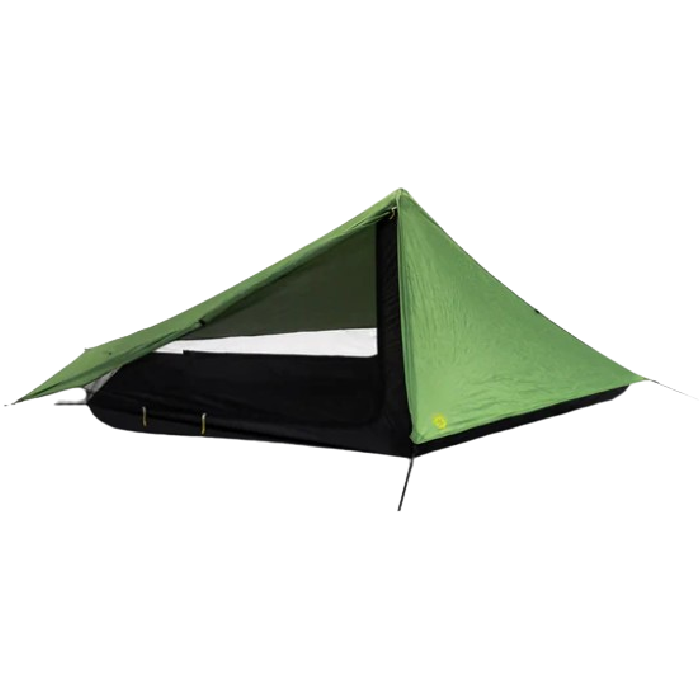
Six Moon Designs Skyscape Scout 1
Best Budget Backpacking Tent
CleverHiker Rating: 4.7/5.0
Price: $160
Weight: 2 lb. 7 oz.
Dimensions (LxWxH): 8.6 x 4 x 3.75 – 23 sq ft
Type: Semi-Freestanding
Pros
- Great for taller people
- Ultralight
- Can store gear easily at the foot and head
- Vestibules roll back for almost all net shelter
- Sufficient headroom
- Stable
Cons
- Condensation issues if improperly ventilated
- Doesn't come seam-sealed
With features like an extended 8.6 feet of length, a semi-freestanding design, and an ultralight weight at just 2.4 pounds, it’s easy to see why the Skyscape Scout tent might appeal to those looking for backpacking tents on a budget. Well thought-out features include a 60/40 offset for the poles, which allow for added headroom and bring the peak height up to 3.75 feet. Despite its double wall design, the Skyscape Scout has incredible ventilation with both vestibules able to fully roll back and reveal an almost complete net shelter for bug protection on warm nights and great stargazing. There is also an integrated cross bar sewn into the roof to help stabilize and open up the ceiling when pitching. It reinforces the rigidity provided by the poles over the top of the shelter to prevent sagging.
The Skyscape Scout is great for solo backpackers prioritizing low weight, but might not be a choice pick for those looking for more comfort and space. Having tested both, we can say with confidence that backpackers looking for a roomier shelter, and who can easily split weight with a hiking partner, should check out the Lunar Duo Outfitter. Another great buy from Six Moon Designs, this tent has increased interior space for 2 people plus their gear and is still great for shorter backpacking trips with a partner. Overall, Six Moon Designs’s Skyscape Scout is an undeniable best budget buy for solo backpackers and those prioritizing low weight.
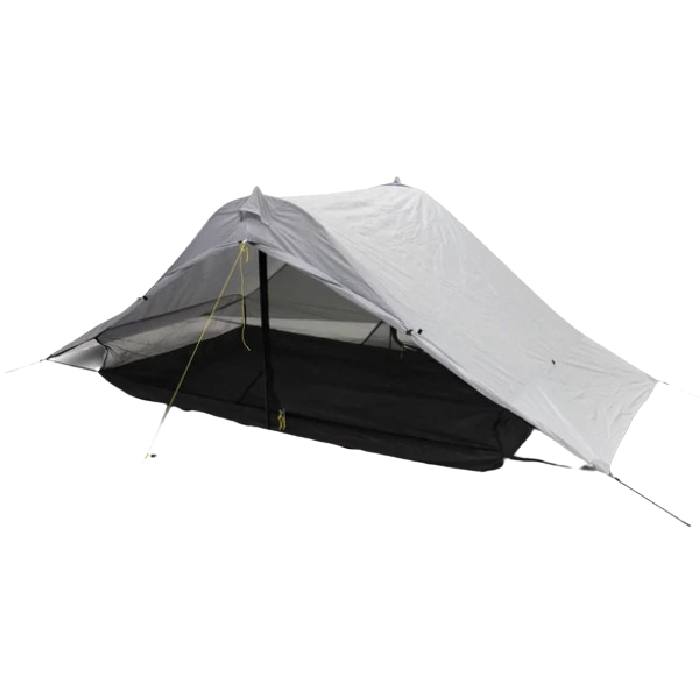
Six Moon Designs Lunar Duo Outfitter
Most Spacious Budget Backpacking Tent
CleverHiker Rating: 4.6/5.0
Price: $210
Weight: 3 lb. 11 oz.
Dimensions (LxWxH): 7.5 x 4.5 x 3.8 – 34 sq ft
Type: Non-Freestanding
Pros
- Easily fits 2 people with gear
- Lots of ventilation
- Good storage features
- Stable
- Great headroom
- Dual doors and vestibules
Cons
- Doesn't come seam-sealed
- Heavy unless splitting weight with a partner
For a non-freestanding backpacking shelter, the Lunar Duo Outfitter delivers unmatched comfort and durability at a great price that is uncommon for most lightweight backpacking tents. With the third largest interior space in the category and increased headroom thanks to small curved roof poles, the Lunar Duo Outfitter easily stands out from the rest in our lineup. As the only other hybrid double wall tent aside from the Skyscape Scout, the Lunar Duo Outfitter had no issue with condensation when thick fog rolled in overnight while camping near Reyes Peak in the Los Padres National Forest. The ample amount of mesh and upper hood vents prevent any moisture buildup on the inner walls.
Luckily in our experience, we didn’t encounter any heavy rain because the Lunar Duo Outfitter is not seam-sealed. Sealer needs to be purchased and applied separately if you anticipate encountering any rain throughout your trip. It’s also worth noting that the Lunar Duo Outfitter is constructed of a more cost-effective 190T polyester, making it a heavier shelter than other backpacking tents. While still very reasonable to carry, it’s much easier and more efficient to split the weight with a partner if you can manage it. Overall, the Lunar Duo Outfitter is a great choice for couples or dog owners who want to confidently explore the backcountry with a comfortable, durable, and reliable shelter that provides protection and peace of mind.
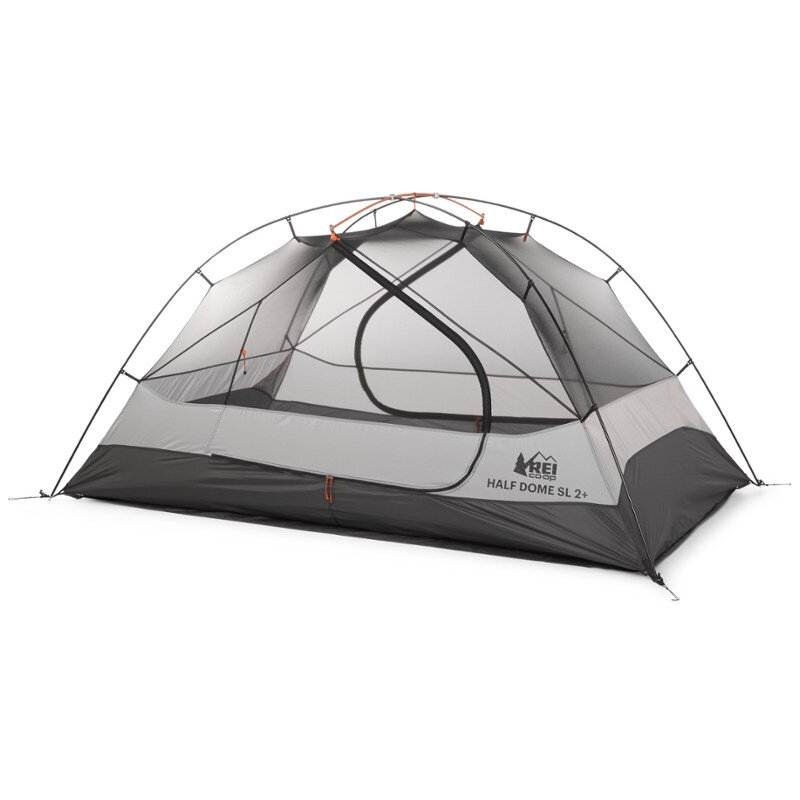
REI Half Dome SL 2+
Best Crossover Tent for Car Camping & Backpacking
CleverHiker Rating: 4.6/5.0
Price: $349
Weight: 4 lb. 15 oz.(including footprint)
Dimensions (LxWxH): 7.5 x 4.5 x 3.5 – 33.6 sq ft
Type: Freestanding
Pros
- Spacious
- Easy color-coded setup
- Protection and privacy from sidewall
- Ample headroom
- Extensive interior pockets and upper loops for drying gear
Cons
- No pole grommets on the included footprint
- Hubbed pole structure is a bit bulky for packing
The REI Half Dome SL 2+ has established itself as a very popular and reliable crossover tent. Its design prioritizes interior space and comfort, making it a standout choice for two occupants plus gear or even a dog. The tent features a specifically designed larger floor plan (hence the 2+), ensuring ample room for comfortable sleeping and storage. A singular, color-coded hubbed pole architecture simplifies and quickens setup. Notably, the stable and vertical sidewalls create generous headroom and maximize usable space within the tent. Thoughtful interior features, including extensive integrated pockets and upper loops for hanging gear, contribute to organized internal storage system any could appreciate. This combination of spaciousness, easy setup, and organizational features positions the Half Dome SL2+ as a strong leader in the crossover tent sub-category within the Budget Tents lineup.
The Half Dome SL2+ does present a few drawbacks, but not many. The included footprint lacks pole grommets, preventing its use in a minimalist “fast fly” setup, which some backpackers prefer for shedding weight. Additionally, while the hubbed pole structure contributes to the tent’s spacious interior, it can be somewhat bulky when collapsed, making it less compact for packing. This bulk, combined with its overall weight of 4.9 pounds, makes it less ideal for serious backpackers prioritizing the absolute lightest gear and covering significant distances. Overall, the REI Half Dome SL2+ offers a compelling balance of comfort, durability, and value, making it a strong choice as a crossover shelter for casual weekend adventurers and shorter, split-weight backpacking trips.
Its spacious interior, easy setup, and thoughtful features justify its price point. The Half Dome SL2+ excels as a versatile shelter for those who prioritize comfort and interior space over minimal weight, bridging the gap between car camping comfort and light backpacking capability.
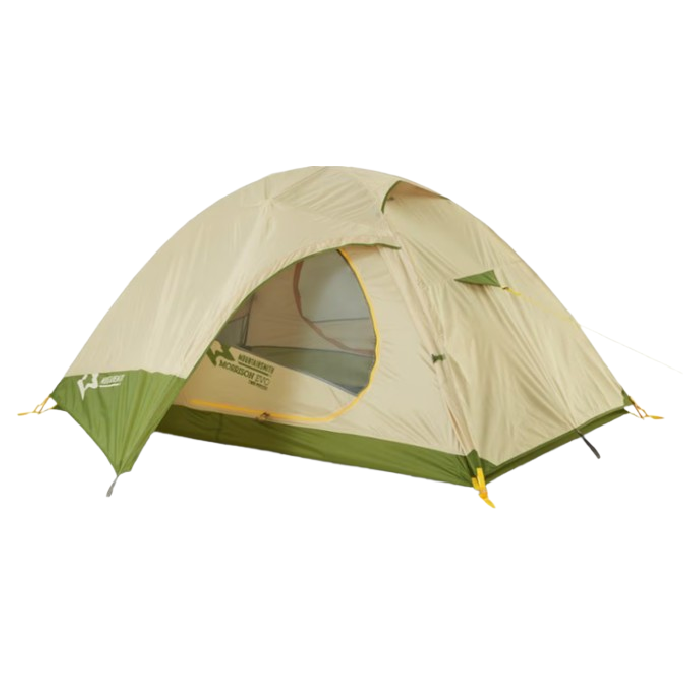
Mountainsmith Morrison EVO 2
Most Spacious & Best Pocket Storage
CleverHiker Rating: 4.6/5.0
Price: $230
Weight: 6 lb. 15 oz.
Dimensions (LxWxH): 7.6 x 4.7 x 3.8 – 36 sq ft
Type: Freestanding
Pros
- Large interior space
- Lots of head and shoulder room
- 11 storage pockets
- Footprint included
- Oversized dual doors and vestibules
Cons
- Too heavy and bulky for backpacking
- Half of vestibule is meant to be staked and can’t be rolled back
The Mountainsmith Morrison EVO 2 is a significant upgrade over its predecessor, the Morrison 2. It’s an excellent choice for campers who prioritize spacious interiors and ample storage. In fact, this tent boasts the largest interior square footage of any tent in the Budget Tents Category.
With a generous 36 square feet of interior space, the Morrison EVO 2 comfortably accommodates two full-size air mattresses plus additional gear. Its length is second only to the Skyscape Scout, which is a single-person tent designed more for lightweight, longer distance backpacking. The Morrison EVO 2, on the other hand, is a true two-person tent, offering plenty of room to move around without feeling cramped or restricted.
Storage is another strong point of the Morrison EVO 2. It comes equipped with a total of 11 pockets, including a removable gear loft with integrated pockets, door stow pockets with dual access, and additional sidewall pockets. These storage options help keep your gear fully organized and off the tent floor, maximizing your usable space and comfort when it comes time for rest.
The Morrison EVO 2 is constructed and fortified with durable 68-denier/185 taffeta polyester with an added 2000 mm polyurethane coating for the fly, 68-denier/185 taffeta polyester for the inner walls, and 68-denier/190 taffeta denier for the floor. While this material provides excellent protection against the elements, it does contribute to the tent’s weight. At 6.93 pounds, the Morrison EVO 2 is the heaviest tent in the category, making it less suitable for any type of backpacking, even if splitting weight with a partner. It is ideal for car camping, where weight is less of a concern and comfort is priority.
Overall, the Mountainsmith Morrison EVO 2 is a fantastic option for car campers who value comfort, space, and durability. Its spacious interior, ample storage, and robust construction make it a top choice for those seeking a premium comfort tent for a convenient camping experience.
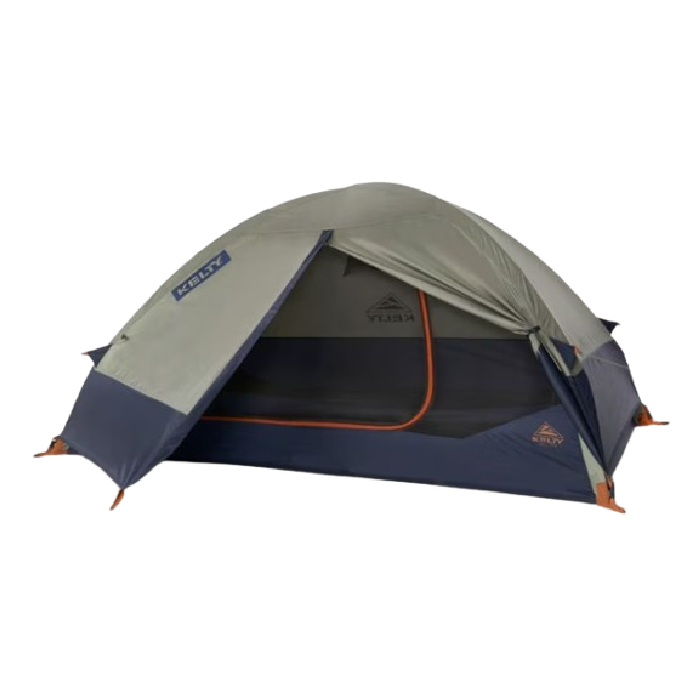
Kelty Late Start 2
Fastest Setup Tent
CleverHiker Rating: 4.5/5.0
Price: $160
Weight: 5 lb. 0.6 oz.
Dimensions (LxWxH): 7.4 x 4.5/3.6 (head/food) x 3.5 – 30.6 sq ft
Type: Freestanding
Pros
- Easy setup
- Pre-attached guy lines with integrated stow pockets
- Durable floor
- Spacious
- Color-coded rainfly
Cons
- One door and vestibule
- Only one rainfly vent
The Kelty Late Start 2 is a great compact tent with some notable features that aren’t available in other model tents in this category. One of these features includes the tent’s built-in stow pouches for extra guy lines, which helped us maximize our limited campsite space by keeping them organized and easily accessible when needed.
After camping in the upper regions of the Los Padres National Forest, we were impressed with this tent’s ability to fit into smaller campsites. Even with big boulders and natural features dotting the landscape, the Late Start 2 had no problem settling into a campsite due to its relatively smaller footprint. This tent is easily pitched in no more than a few minutes thanks to its quick corner pockets for the pre-bent poles, quick clips, and color-coded fly, which prevent any confusion during setup.
However, this tent’s thicker fabric does not compress well so it may take up more volume than other lighter nylon materials would. Due to this, it might not be a first choice for backpackers because of the amount of space it would occupy in a backpack compared to more packable tent models.
However, for an uncomplicated and undemanding tent that almost pitches itself, look no further than the Kelty Late Start 2. With a thick 68D polyester material, this easy-to-pitch shelter is more than capable of withstanding many seasons of rough outdoor use as well as the company of your favorite furry friend.
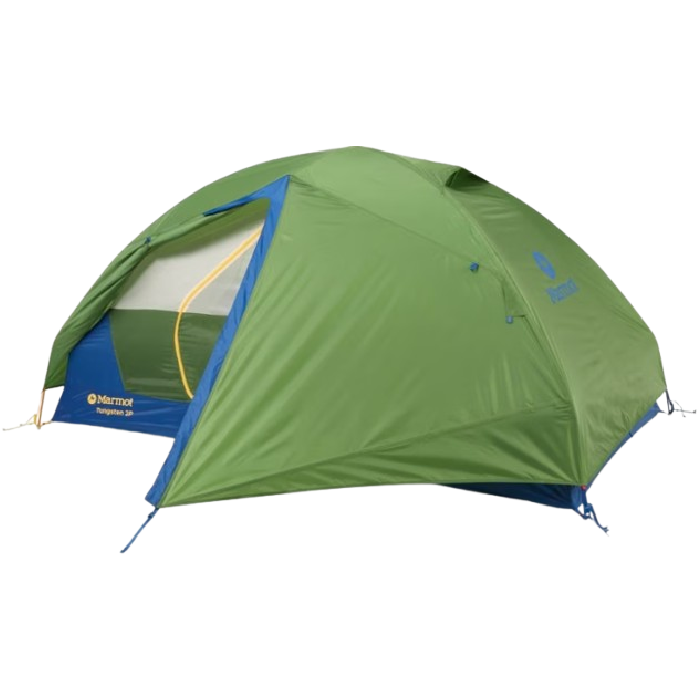
Marmot Tungsten 2
Most Livable Interior Space
CleverHiker Rating: 4.4/5.0
Price: $249
Weight: 6 lb. 3 oz.
Dimensions (LxWxH): 7.3 x 4.5/3.8 (head/food) x 3.5 – 30.1 sq ft
Type: Freestanding
Pros
- Easy color-coded setup
- D-style doors for quick and easy access
- Good waterproofing features
- Roomy
- Lots of storage
- Tent comes in two other sizes
Cons
- Too heavy for backpacking
- Tapered floor plan might feel restrictive
The Marmot Tungsten 2 tent shines as a spacious and well-designed shelter to elevate your next camping experience. Its generous interior boasts 30.1 square feet of floor space and a length exceeding 7 feet. This provides ample room for two campers to stretch out and relax after a day of outdoor activities.
The Tungsten 2 is thoughtfully complemented by a suite of organizational features, including two expansive, double-tiered hanging pockets perfect for stashing smaller items like headlamps or phones. Five upper loops offer convenient hanging points for lights, makeshift clotheslines, or carabiners to maximize vertical space and keep the tent floor clutter-free. A unique light-diffusing lamp shade pocket transforms a headlamp into a soft, ambient light source, creating a cozy atmosphere inside the tent at night.
The Tungsten 2 prioritizes simplicity with intuitive design elements like color-coded pole tips and corresponding rainfly attachment points, which streamline the setup process to under 5 minutes. This quick and hassle-free pitching is a welcome feature, especially when arriving at a campsite after dark or in inclement weather. Dual vestibules also provide a valuable 16 square feet of covered outdoor storage, ideal for stowing muddy boots, backpacks, or other gear, while preventing dirt and moisture from entering the sleeping area.
Despite its numerous advantages, the Marmot Tungsten 2 presents some limitations for certain users. While the tapered floor plan is generally imperceptible when sitting, taller individuals who prioritize maximum shoulder room while sleeping might find it slightly constricting.
This tent is not designed for weight-conscious backpackers and is most appropriate for car camping scenarios where portability over long distances is not a primary concern. Even though it forgoes some of the specialized features found in dedicated backpacking tents, the Marmot Tungsten 2 is a highly functional and livable tent perfectly suited for car campers who value space, organization, and ease of setup.
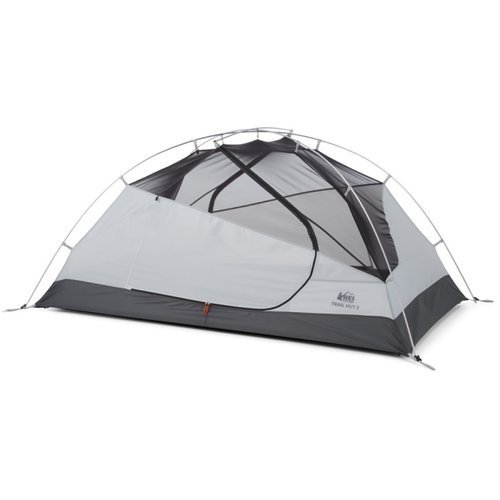
REI Trail Hut 2
Best Well-Rounded Features
CleverHiker Rating: 4.3/5.0
Price: $229
Weight: 5 lb. 11 oz.
Dimensions (LxWxH): 7.3 x 4.3 x 3.3 – 31.7 sq ft
Type: Freestanding
Pros
- When rolled back, the fly doors do not cut off the entryway
- Equal-sized x-poles and clips for fast setup
- Fly doors roll back over the roof for stargazing and added ventilation
- Ridgepole adds increased interior headroom and shoulder space
- High-cut side walls add increased privacy and wind protection
Cons
- Compact; small dimensions and low peak height for taller people
- Too heavy for longer distance solo backpacking
The REI Trail Hut 2 is a versatile and well-rounded tent that offers a great balance of features and affordability. While it’s not the lightest or cheapest option out of the budget tents category, it’s still a very solid choice for frontcountry car camping or short backpacking trips with a partner. It was perfect when we camped in the higher altitude forest near Reyes Peak.
One of the standout features of the Trail Hut 2 is its spacious interior feel, despite its compact footprint. With over 7 feet of length and more than 4 feet of width, we were able to fit 2 full size adult air mats inside. The large dual doors and vestibules offer convenient entry and exit points, as well as an accessible protected storage space for wet gear, backpacks, and boots.
High-cut sections of side walls provide privacy and added wind protection, while the lower sections offer ventilation when the fly is removed. The double-tier sections of the rainfly doors can be partially or fully tied back over the roof. This not only promotes extra ventilation, but also makes it an ideal shelter for stargazing and enjoying extended outdoor views from inside the tent.
This tent’s construction is durable and weather-resistant with a polyester taffeta and nylon mesh combination, along with a DWR polyurethane coating and seam-sealed floor and rainfly for added protection. This defends against the elements, even in harsh weather. Bolstered by the extra guy line attachment points, the Trail Hut 2 has great stability when fully staked out. Overall, the REI Trail Hut 2 is a fantastic choice for campers seeking a reliable, easy-to-use, and feature-rich tent that won’t break the bank.
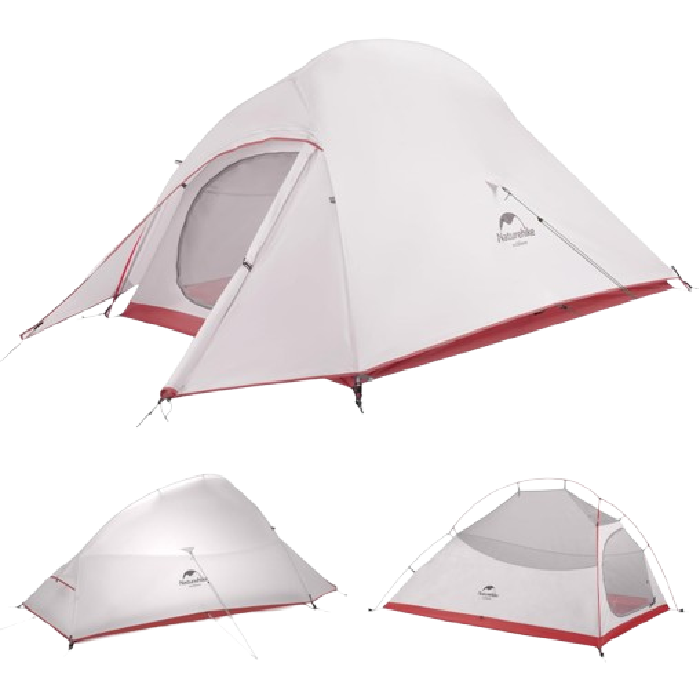
Naturehike CloudUp 2
Best Budget Backpacking Tent
CleverHiker Rating: 4.2/5.0
Price: $170
Weight: 3 lb. 7 oz.
Dimensions (LxWxH): 6.9 x 4.1 x 3.4 – 27.9 sq ft
Type: Freestanding
Pros
- Lightweight enough for backpacking
- High sidewall for privacy
- Quick and easy to pitch
- Included footprint
- Packable
- Quality materials
- Fly can be used separately as a sunshade
Cons
- Too short for people over 6 ft
- Single front-entry and small vestibule
The Naturehike CloudUp 2 lands itself firmly as a decent crossover tent for people under six feet tall. As a smaller, more compact shelter, with a slim 3.4 lb weight, it lends itself well for short solo backpacking trips and frontcountry excursions. It is constructed of lightweight 20-denier silicone coated nylon with an added polyurethane 4000 mm coating and taped seams for a robust barrier against heavy rainfall. Not to mention, the high quality hardware consists of durable thin gauge guy line and eleven 6” Y-stakes to keep the pullout points secure in high wind.
During testing, we found that anyone six feet or taller would not be comfortable with the CloudUp 2’s smaller 82.8 inch length and 40.8 inches of peak height. Its smaller, more compact dimensions would also struggle to accommodate two full size people plus gear, especially with the single door entryway. Storage is pretty limited with the singular smaller vestibule and only one interior pocket above the door. Based on our experience, we feel that the CloudUp 2 is much more suitable for a solo hiker under six feet tall.
Overall, the Naturehike CloudUp 2 is a suitable crossover tent for frontcountry car camping and short range solo backpacking trips. Its simple and stable Y-pole design allows for a quick setup. Extra pullout points can be firmly secured with thin-gauge guy lines and Y-stakes which are unlikely to bend. Although not recommended for two people due to its one-door design and more compact size, the CloudUp 2 is a solid tent for solo campers who enjoy both backpacking and car camping.
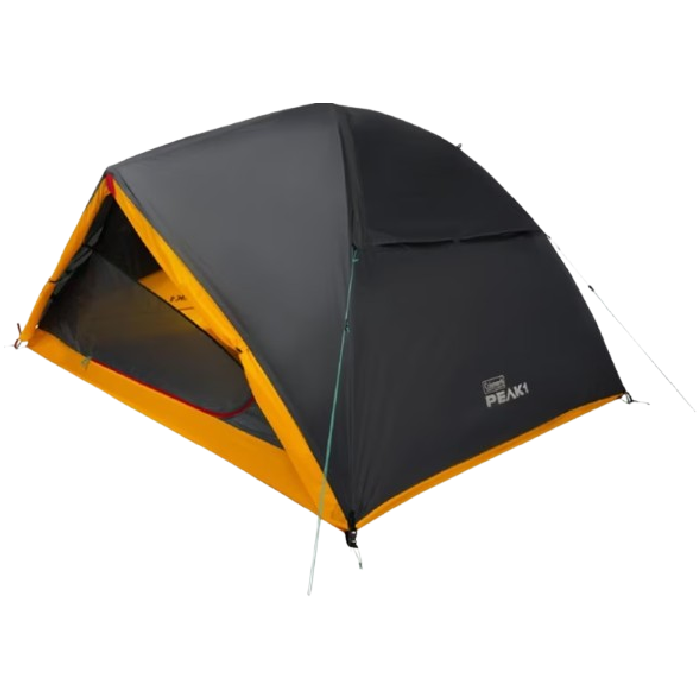
Coleman Peak 1
Best Modern Update with Great Stargazing
CleverHiker Rating: 4.2/5.0
Price: $270
Weight: 6 lb. 1 oz.
Dimensions (LxWxH): 7.3 x 4.3 x 3.5 – 31.7 sq ft
Type: Freestanding
Pros
- Stargazing panel
- Color-coded rainfly
- Easy door access and good headroom
- High-cut sidewalls
- Carrying sack is a roll-top drybag with extra packing space
Cons
- Mesh is very fragile
- When rolled back, the rainfly doors cover up a portion of the entryway
The Coleman Peak 1 is a feature-rich 2-person tent from a trusted brand in the outdoor industry. Designed with versatility in mind, it caters to various group sizes with two, three, four, and six-person models. The Peak 1 prioritizes durability and weather resistance, making it suitable for challenging three-season conditions. Constructed with 68-denier polyester for the fly, floor, and canopy and a 2000mm waterproof rating with taped seams, the Peak 1 offers reliable protection from the elements. The inclusion of a footprint, extra guy-line pull-outs, and sturdy 7000-series aluminum poles capable of withstanding 45 mph winds further enhance its resilience.
Beyond its protective qualities, the Peak 1 incorporates good design elements for enhanced usability. A stargazing roof panel not only provides stunning views and excellent ventilation, but also doubles as a convenient access point from the outside. The color-coded rainfly ensures quick and correct setup, while the offset ridgepole maximizes interior headroom, widens the ceiling, and facilitates easy door access. High-cut inner sidewalls offer increased wind protection and privacy when the rainfly is removed and the thick roll-top drybag carrying sack provides ample packing space and a quick way to conveniently transport the tent.
The Coleman Peak 1 isn’t without drawbacks though. While the mesh panels offer excellent ventilation, they are notably delicate and require careful handling during setup to prevent tears or snags from prickly vegetation. Another thing to consider is the positioning of the rainfly doors when rolled back, which partially obstruct the entryway. This can be inconvenient when entering or exiting the tent especially with gear. Furthermore, at 6.1 pounds, the Peak 1 leans toward the heavier side for a backpacking tent. Its relatively long 21 inch pole sections and bulkier polyester material make it less compressible and packable than other nylon alternatives.
The Coleman Peak 1 is a well-built shelter ideal for car camping, weekend getaways in the frontcountry, and for those who prioritize durability and comfort over minimal weight. Backpackers looking to minimize weight and pack for longer treks should consider lighter, more compressible options. Ultimately, the Coleman Peak 1 excels as a durable and comfortable car camping tent, offering excellent value for those who prioritize those qualities.
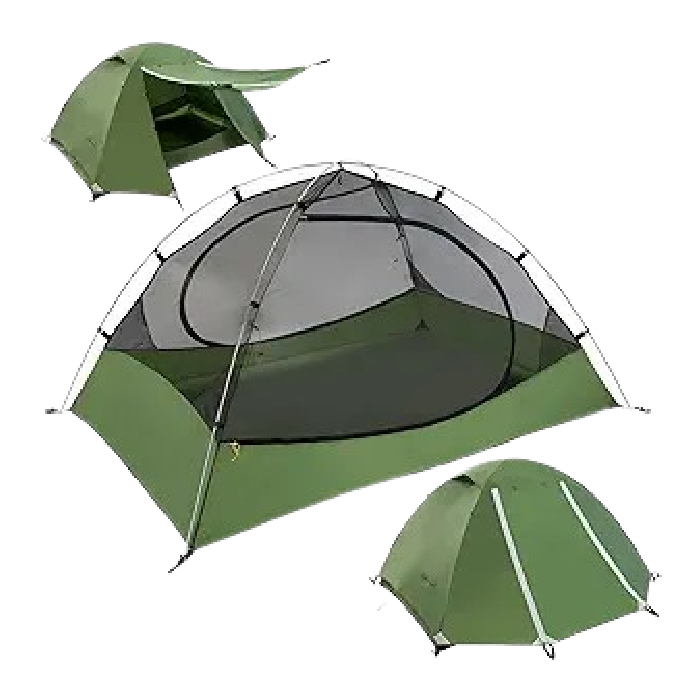
Clostnature Polaris 2
Most Affordable Budget Tent
CleverHiker Rating: 4.0/5.0
Price: $80
Weight: 5 lb. 5 oz.
Dimensions (LxWxH): 7.2 x 4.9 x 3.8 – 35 sq ft
Type: Freestanding
Pros
- Deployable shade awning for sunny days (requires poles)
- Familiar and simple-to-use dome-style structure
- Dual doors for easy and quick access
- Convenient and easy-to-use carrying bag with handles
- Lots of interior space for two people, dog, or gear
- Double reinforced corners for fabric longevity and delayed fraying
Cons
- 5 pound weight is too heavy for backpacking
- Shade awning is susceptible to wind and may flap around
The Clostnature Polaris 2 surfaced as the most affordable tent in the Budget Tents Category. Second only to the Morrison EVO 2 in total interior square footage with a generous 35 sq ft., this tent offers one of the largest interior spaces compared to all the tents we reviewed in this category. It also boasts the least expensive price in the entire lineup. Its simple yet effective design is easy to use for a very quick setup and includes handy features that will make your trip even more enjoyable.
With a familiar and simple dome-style structure that is pitched with two equal sized x-poles and a corresponding clip system, this tent is a breeze to set up and take down in minutes. After the fly is clipped in via the buckles on the four corners, the vestibules stake out to complete the process. This tent is perfect for those looking for a straightforward shelter that pitches effortlessly. One of the vestibules also converts into a shade awning where you can relax out of the heat in shadeless and exposed campsites.
This tent came in handy while our gear analyst camped out on the sunny trails of the Santa Monica Mountains where shade can be elusive and the heat can feel inescapable at times. However, this tent might not be for everyone, especially if you are searching for something lighter and more suitable for backpacking. Though If you just need an easy-to-use car camping tent for weekend camp getaways, then this tent is for you.

Product Comparison Table
| oSort | Product | Price | Dimensions (LxWxH) | Weight | Type | Comfort | Weather Resistance | Durability | Portability | Ease of Use | 0 |
Tarptent Stratospire 2 View at Garage Grown Gear |
$259 | 7.2 x 4.3 x 4 – 31.1 sq ft | 2 lb. 11 oz. | Freestanding | 4.5 | 4.7 | 4.6 | 4.6 | 4.1 | 1 |
Six Moon Designs Skyscape Scout 1 View at Six Moon Designs |
$160 | 8.6 x 4 x 3.75 – 23 sq ft | 2 lb. 7 oz. | Semi-Freestanding | 4.5 | 4.2 | 4.5 | 4.7 | 4.6 | 2 |
Six Moon Designs Lunar Duo Outfitter View at Six Moon Designs |
$210 | 7.5 x 4.5 x 3.8 – 34 sq ft | 3 lb. 11 oz. | Non-Freestanding | 4.5 | 4.2 | 4.5 | 4.3 | 4.4 | 3 |
REI Half Dome SL 2+ View at REI |
$349 | 7.5 x 4.5 x 3.5 – 33.6 sq ft | 4 lb. 15 oz. (including footprint) | Freestanding | 4.5 | 4.6 | 4.6 | 4.3 | 4.1 | 4 |
Mountainsmith Morrison EVO 2 View at Amazon View at REI |
$230 | 7.6 x 4.7 x 3.8 – 36 sq ft | 6 lb. 15 oz. | Freestanding | 4.7 | 4.5 | 4.5 | 3.8 | 4.2 | 5 |
Kelty Late Start 2 View at Amazon View at Kelty |
$160 | 7.4 x 4.5/3.6 (head/food) x 3.5 – 30.6 sq ft | 5 lb. 0.6 oz. | Freestanding | 4.5 | 4.2 | 4.4 | 4.3 | 4.6 | 6 |
Marmot Tungsten 2 View at REI View at Marmot |
$249 | 7.3 x 4.5/3.8 (head/food) x 3.5 – 30.1 sq ft | 6 lb. 3 oz. | Freestanding | 4.6 | 4.5 | 4.5 | 3.9 | 4.5 | 7 |
REI Trail Hut 2 View at REI |
$229 | 7.3 x 4.3 x 3.3 – 31.7 sq ft | 5 lb. 11 oz. | Freestanding | 4.3 | 4.4 | 4.3 | 4.1 | 4.5 | 8 |
Naturehike CloudUp 2 View at Amazon View at Naturehike |
$170 | 6.9 x 4.1 x 3.4 – 27.9 sq ft | 3 lb. 7 oz. | Freestanding | 3.7 | 4.4 | 4.5 | 4.4 | 4.2 | 9 |
Coleman Peak 1 View at REI View at Amazon |
$270 | 7.3 x 4.3 x 3.5 – 31.7 sq ft | 6 lb. 1 oz. | Freestanding | 4.2 | 4.4 | 4.5 | 4.0 | 4.5 | 10 |
Clostnature Polaris 2 View at Amazon |
$80 | 7.2 x 4.9 x 3.8 – 35 sq ft | 5 lb. 5 oz. | Freestanding | 4.3 | 4.4 | 4.4 | 4.2 | 4.3 |
|---|

How We Test
COMFORT
This metric involved a comprehensive assessment of the tent’s interior dimensions and comfort. Key measurements included total floor area with and without gear, peak height, total capacity, and shoulder and headspace while sitting and lying down.
Accessibility was evaluated based on size, configuration, number of doors, zipper quality, and fly configuration. We also noted and assessed whether or not the rainfly doors block or restrict the entryway when rolled back. Additionally, the presence and functionality of interior pockets, gear lofts, hanging support, and organizational features were noted as well.
Tent shape was examined to identify potential head or toe contact points, especially when using an air mattress. We also considered each tent’s suitability for hosting one or two occupants, while considering factors like interior space, gear storage, and privacy. The height of the sidewalls and the opacity of the fabric were also evaluated to determine their impact on comfort, visibility, privacy and ventilation.
WEATHER RESISTANCE
This metric assessed the resilience of each shelter model in various simulated weather conditions. Key factors examined included structural integrity, waterproofing capabilities, and overall design effectiveness. This involved evaluating the materials used, the construction quality, the seam-taping and stitching, and the effectiveness of the bathtub floor.
In the absence of specific conditions needed for testing, the shelters were exposed to simulated wind tests by vigorously shaking the structure to assess their stability, noise levels, and potential stress points before, during, and after each test was applied. Waterproofing was tested through a one minute manual application by a hose on a shower setting, while someone else sat in the interior to check for leaks and evaluate the performance of vestibules, interior dryness, and fabric water repellency from inside.
Additionally, the quality of guyline attachment points, stitching, and seam-taping was inspected. Thermal performance, ventilation, and the presence of shading features were also considered. By analyzing these factors, we gained a comprehensive understanding of each shelter’s strengths and weaknesses in real-world conditions.
DURABILITY
All tents were rigorously tested for fabric tensile strength and evaluated to assess overall resistance to tears and punctures, particularly when exposed to rough surfaces or sharp and pointy objects. Floor durability was examined, while considering each tent’s need for a footprint to see if it could adequately protect air mattresses from punctures and prevent tears and holes occurring in the fabric.
Pole and stake quality were assessed, including their resistance to bending and breaking under stress. A pole bend-test was applied to confirm flexibility and stakes were vigorously hammered into various terrain like packed dirt, rocky soil, mud, and sand. Guy line attachment points were inspected for secure connections, adequate stitching, and potential failure points from stress. Guy lines themselves were evaluated for durability, reflectivity, gauge, and the quality of their line-locks.
Finally, the tent’s overall design was scrutinized for overall potential weak points or design flaws that could compromise its longevity and functionality. By identifying and addressing these issues, the tent’s durability and reliability can be optimized for extended outdoor use and many camping seasons.
PORTABILITY
Tent portability was rigorously assessed during field testing. We conducted a detailed inventory to assess the quality of all components and hardware, ensuring that everything was present and determining how easily it could also be repacked. The tent’s minimum trail weight was tested on a 2-5 mile hike, even if its intended use was not backpacking, so that we could evaluate its impact on overall pack weight, comfort, and viability for being a crossover shelter. Setup and breakdown times were measured and averaged, along with the ease of relocating the tent without full disassembly.
The presence and effectiveness of the carrying sack, including its handles, compression straps, and storage solutions were all examined, as well as the feasibility of carrying the tent by hand, outside of a backpack. The length of any folded poles and stakes were also measured.
By systematically evaluating these factors, we gained a comprehensive understanding of the tent’s portability and suitability for backpacking, car camping, or use as crossover shelter.
EASE OF USE
When field testing these tents, the last metric we focused on was ease of use, a crucial factor for campers. We took into account the average setup time across many pitches and breakdowns, overall footprint area with deployed features, stake quality and quantity, pole and clip system efficiency, rainfly attachments and configurations, tension mechanisms, and interior features.
Basic setup time was considered with factors like poles, clips, and fly attachment, but not with full tensioning because that’s largely optional. Footprint area was examined to determine the tent’s required minimum and maximum space. Stake quality was evaluated through pull and force tests to assess their durability and ease of insertion/removal. Pole systems were examined for their material, packed length, attachment method, flexibility, and the inclusion of repair splints.
Fly attachment was assessed for its ease of setup, color-coded features, guy out attachments, and impact on entry and exit points. Tension mechanisms, including guy line attachment points, line-locks, and reinforced points, were tested for their effectiveness while they were slack and also while they were under tension. Interior features like doors, vestibules, zippers, tie-backs, pockets, and lofts were evaluated for their quantity, size, placement, and functionality. By systematically analyzing these factors, a comprehensive understanding of each tent’s ease of use and overall performance was achieved.
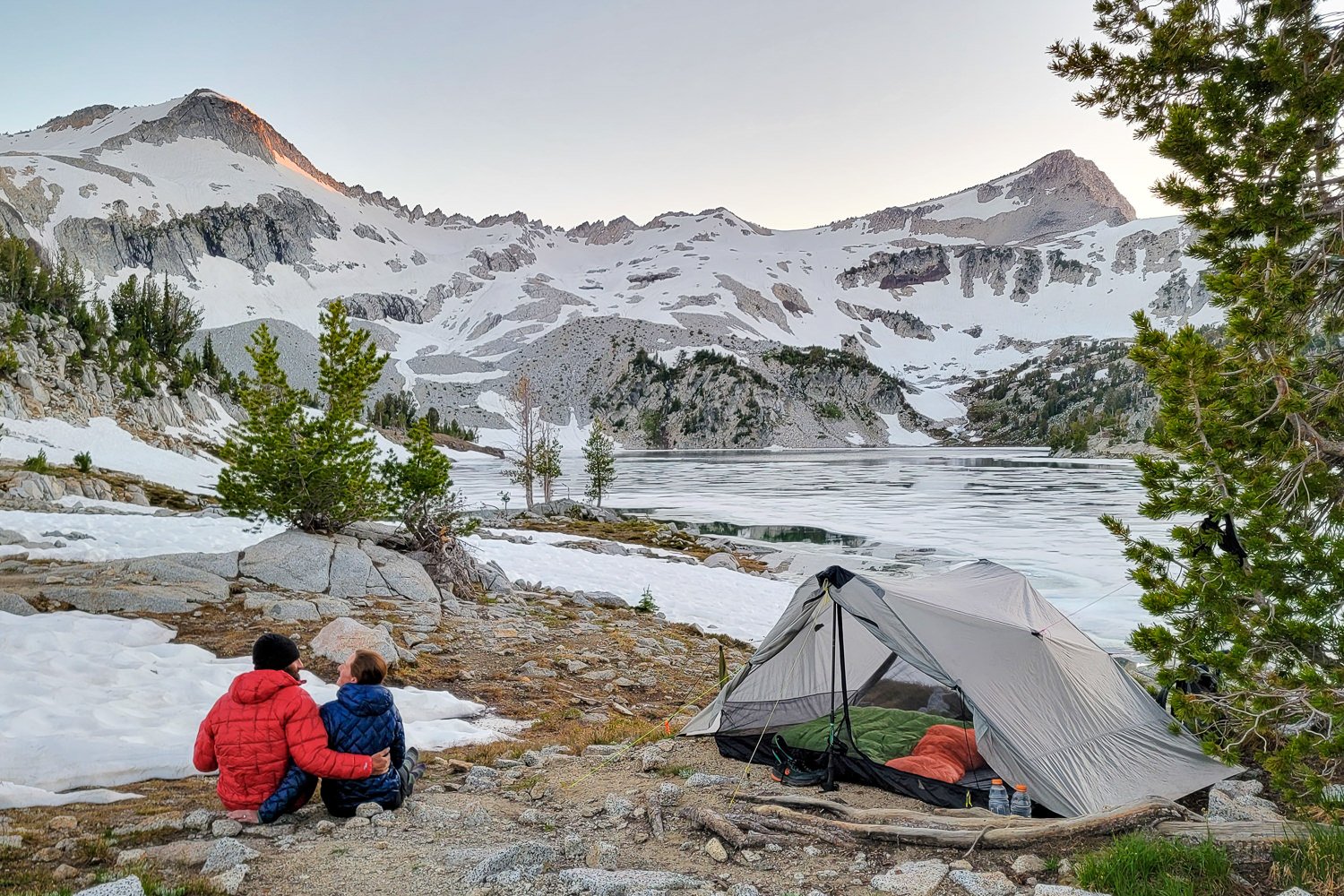
Why Trust CleverHiker?
With years of experience and immersion in the great outdoors, we continuously hone our skills as seasoned campers, backpackers, and outdoor enthusiasts. Gear Analyst Lawrence McLinden has hiked and backpacked in remote locations such as the rugged backcountry beaches of California’s Channel Islands to the vast Sierra Nevada and surrounding high deserts, down to the southern coastal ranges and the Los Padres and Angeles National Forests.
His passion for outdoor adventure extends beyond hiking and backpacking, encompassing overlanding and dispersed camping with friends as well as decades of snowboarding in places like the Sierra Nevada, Whistler B.C., and San Bernardino Mountains. He has also completed two avalanche safety courses in the Eastern Sierra Nevada in accordance with AIARE, enabling safe and confident navigation in winter backcountry terrain.
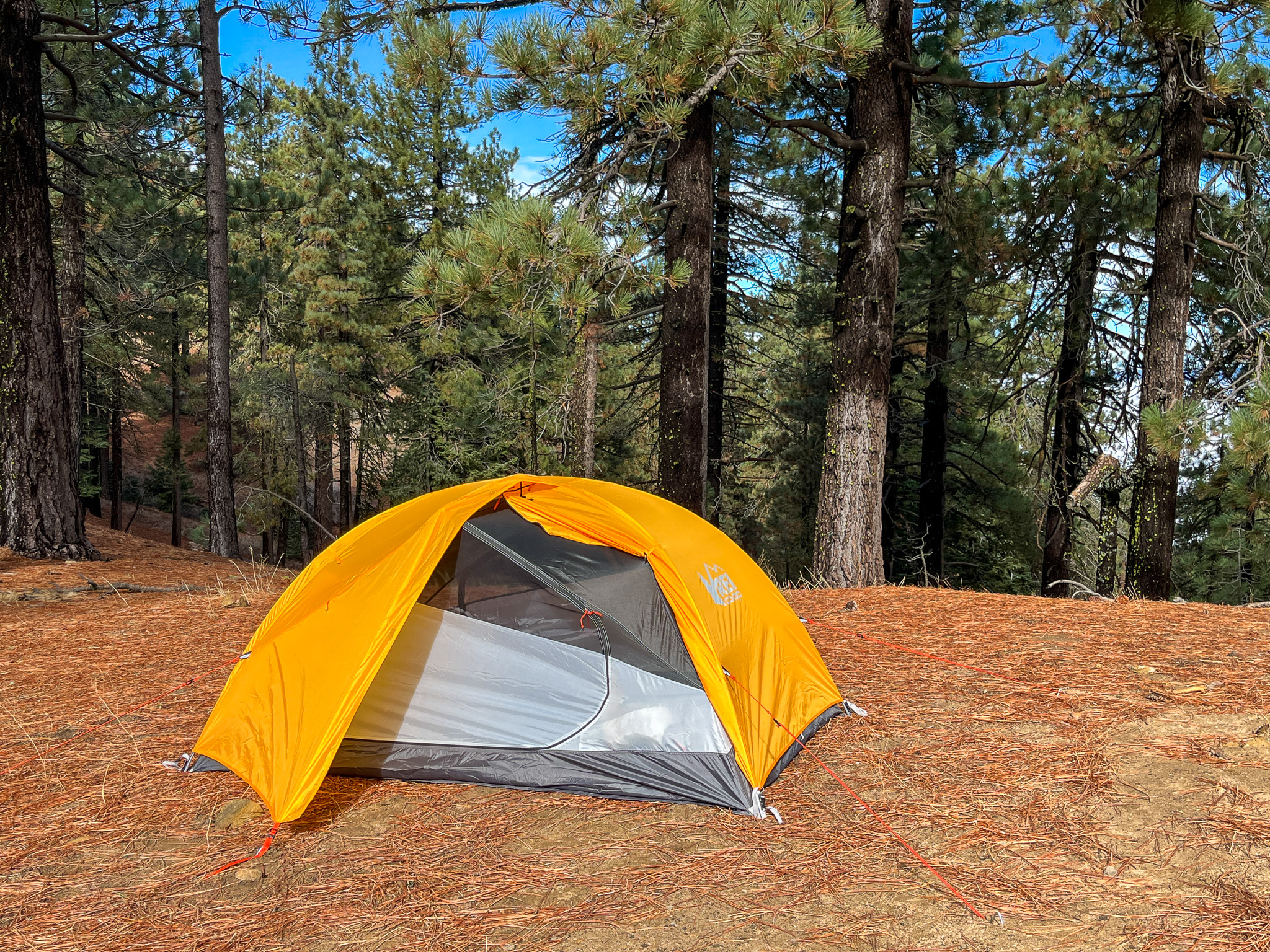
Analysis & Results
Budget tents can offer a surprising balance between affordability and features. While they may not match the premium aspects of high-end models, they often exceed expectations for their reasonable price point and unique characteristics, providing a surprisingly reliable and quality shelter.
All of the tents ranked in the Budget Tents category were scored and assessed on five separate metrics including comfort, weather resistance, durability, portability, and ease of use. Results and comparisons for each are shown below starting with value.
VALUE
The REI Trail Hut 2 emerges as a clear top performer in terms of value, but at the highest price point. It boasts a high overall score due to its superior crossover capabilities, interior room, and reasonable weight, making it a compelling choice for budget-conscious campers who prioritize comfort, quality materials, and the right balance for frontcountry and backcountry adventuring.
The Coleman Peak 1 and Marmot Tungsten 2 also demonstrate strong value, but offer different features such as a more compact footprint, heftier polyester materials and a more affordable price. They are less suited for backpacking and more so for car camping.
However, it’s important to note that the REI Half Dome SL2+ and Tarptent Stratosphere 2 have higher overall rankings, but are also priced significantly higher, potentially making them less attractive options for budget-minded consumers.
COMFORT
The top-performing tents consistently excelled in key comfort factors such as spaciousness, headroom, ventilation, and ease of setup. These tents offered ample room for two occupants, allowing for comfortable movement and gear storage. The generous headroom provided a sense of openness and reduced the feeling of claustrophobia often associated with smaller tents. Additionally, these tents featured effective ventilation systems that maintained a comfortable interior temperature and reduced condensation, ensuring a pleasant camping experience even in challenging weather conditions.
Among the top performers, the Six Moon Designs Skyscape Scout and Lunar Duo Outfitter were particularly noteworthy for their innovative hybrid-wall designs and lightweight construction. Even though they are made of thicker materials, these tents kept the ultralight backpacker in mind without compromising comfort and space. The Lunar Duo Outfitter has the second largest square footage of all the tents and the Skyscape Scout has an extended 100+ inch length for tall hikers. They utilize high-quality materials and advanced construction techniques, resulting in spacious and well-ventilated shelters that are easy to carry and set up.
The Mountainsmith Morrison EVO 2 also impressed with its unmatched 36 square foot interior, superior comfort, and durability. This tent offered a balance of spaciousness and weather protection that stood out from the rest, making it suitable for a wide range of camping conditions. Its robust construction, space, and attention to detail ensures a comfortable and reliable experience.
The Marmot Tungsten 2, with its light diffuser pocket and ridge pole, and the Tarptent Stratospire 2’s four foot peak height, are more examples of tents that excelled in comfort and performance. These models provided surprisingly ample space, good ventilation, and stability – making them ideal choices for comfort, even as two completely different styled tents .
While all the tents in our lineup offered a comfortable camping experience, the top-performing models stood out for their exceptional combination of spaciousness, ventilation, ease of setup, and overall livability – providing a comfortable and enjoyable camping experience.
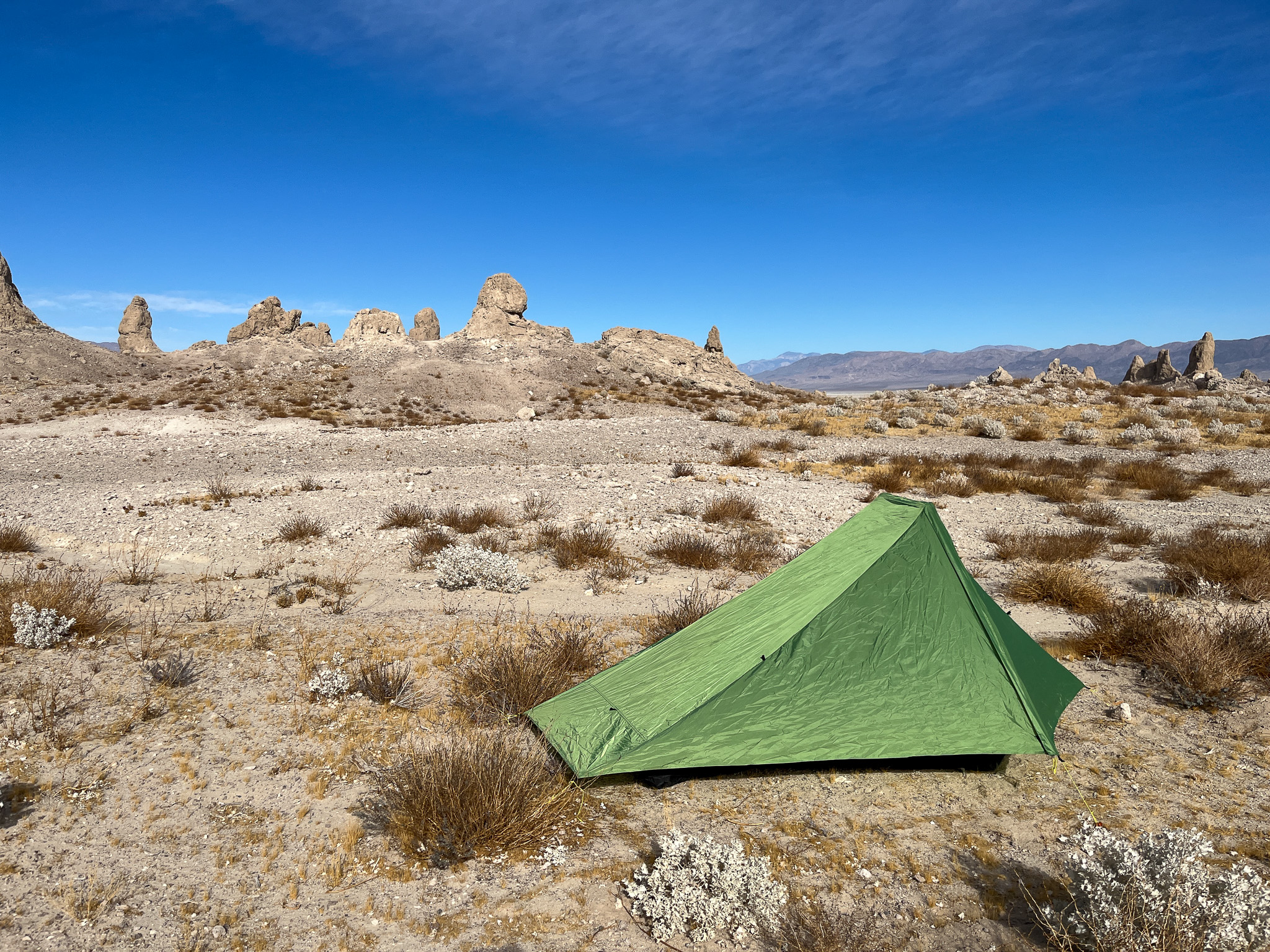
WEATHER RESISTANCE
While all the tents exhibit a commendable level of protection against adverse weather conditions, some models stand out more due to their superior performance, materials, and features that help mitigate wind and rain.
The top-performing tents, including the Tarptent Stratospire 2, consistently demonstrate exceptional weather resistance capabilities due to superior materials and weatherproofing. Specifically engineered to withstand strong winds, heavy rainfall, and even snowfall, they are ideal for camping in challenging environments. Their robust construction, advanced materials, and innovative design features contribute to their ability to provide reliable shelter in extreme weather conditions.
Other tents, like the REI Half Dome SL2+ and Naturehike CloudUp 2, also showcase impressive weather resistance thanks to their fully seam-sealed nylon PU coated fabrics. While other models may not come with the same level of waterproofing from the manufacturer like the Skyscape Scout and Lunar Duo Outfitter, that doesn’t mean that can’t be sealed at home. They still offer a high degree of protection against the elements.
The Kelty Late Start 2 and the Coleman Peak 1, while still offering good weather resistance, may not be as well-equipped to handle the most extreme conditions because of their lower watershed ratings. These tents are likely more suitable for camping in milder weather environments or for those who prioritize other factors like comfort, ease of setup or unique design features meant to be enjoyed in the frontcountry.
Overall, it is very important to consider weather resistance and fabric material when selecting a tent. While all the tents that we evaluated offer varying degrees of protection, the top-performing models consistently demonstrated superior performance in challenging weather conditions because of their material, sealed seams and waterproofing abilities.
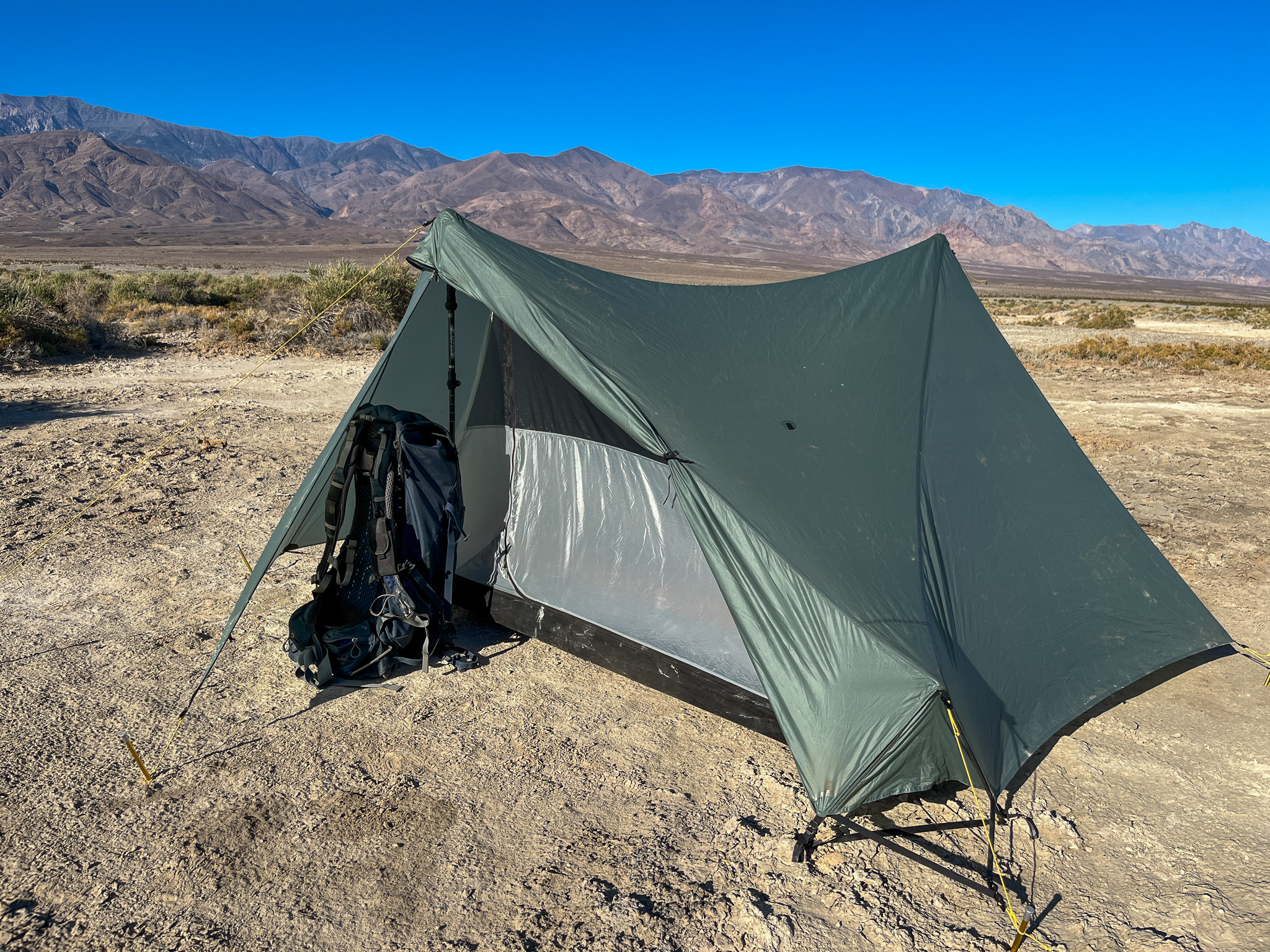
DURABILITY
During testing, all tents demonstrated varying levels of durability, though overall performance remained consistent. Some models excelled in specific areas, while others used different materials and designs, which significantly impacts their long-term lifespan.
The Lunar Duo Outfitter and the REI Half Dome SL2+ exhibit remarkable durability, showcasing their ability to withstand harsh conditions and frequent or rougher use. Both tents feature robust materials, providing a sense of security and longevity. However, the Lunar Duo Outfitter might have a slight edge in terms of its durability with its thicker 190T polyester, compared to the lightweight and thinner nylon of the Half Dome.
Although notably heavier than other tents made of lighter materials, the stronger polyester-based tents, such as the Six Moon Designs models and the Morrison EVO 2, also demonstrate impressive durability – offering a balance of strength and affordability. These tents are well-suited for providing reliable long-lasting shelter without breaking the bank. Models like the Marmot Tungsten 2 and REI Trail Hut 2 provide a good balance of durability and comfort, making them suitable for frontcountry car camping.
Most tents are chosen based on individual preferences and specific needs. Backpackers seeking lightweight and robust shelter may opt for the Tarptent Stratospire 2, while car campers prioritizing comfort and durability might choose the Mountainsmith Morrison EVO 2. Ultimately, the best tent is the one that meets your specific requirements and provides reliable protection during your outdoor adventures.
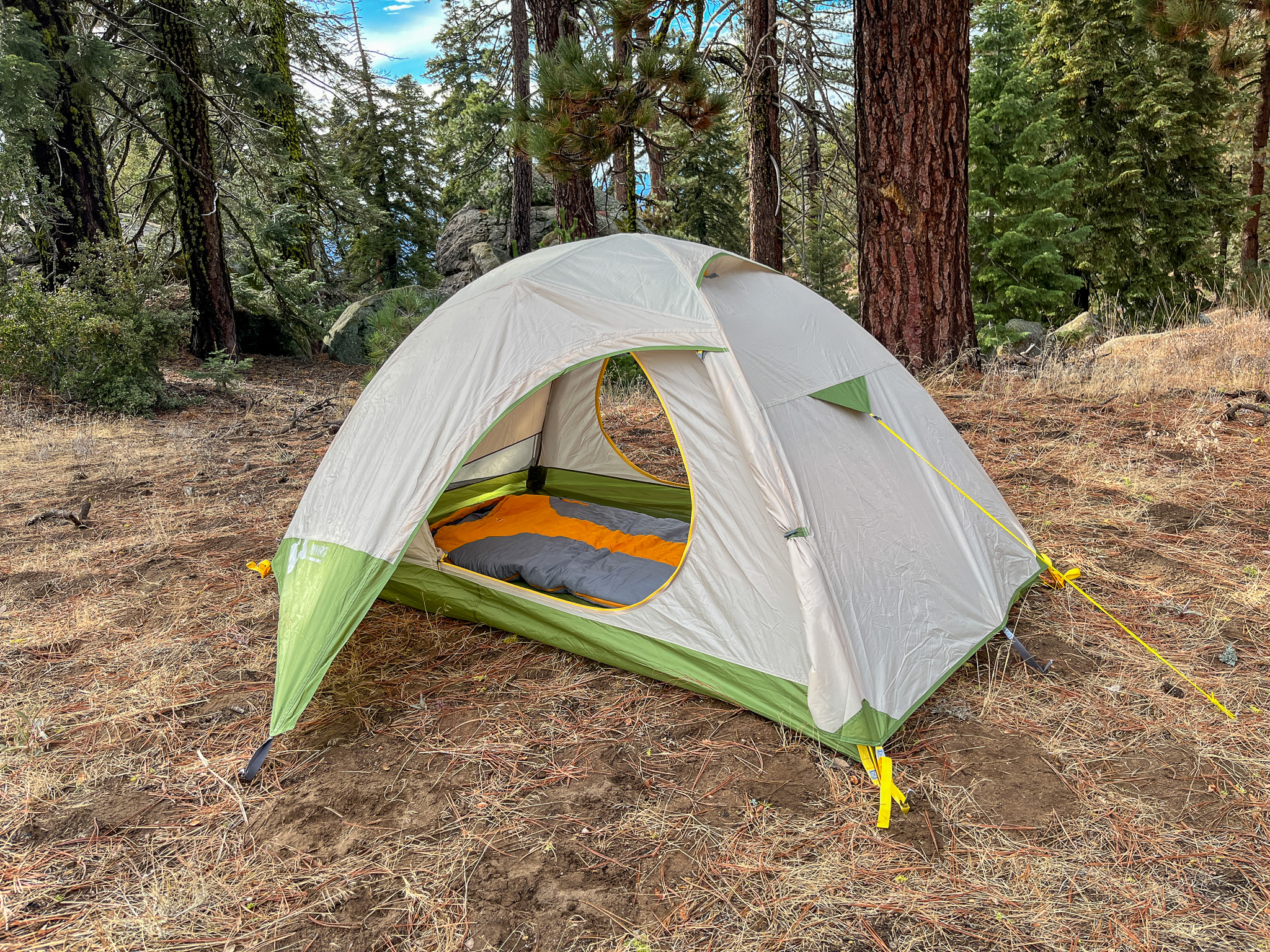
PORTABILITY
The portability of a tent is a critical factor for backpackers and hikers, as it directly impacts the weight and bulk they carry on their journeys. When considering the portability of these tents, a few key aspects stand out: packed size, weight, and ease of setup.
In terms of packed size, the Six Moon Designs Skyscape Scout and Tarptent Stratospire 2 are top picks. These tents pack down incredibly small, making them ideal for ultralight enthusiasts who prioritize minimal weight and pack volume.
On the other end of the spectrum, tents like the REI Trail Hut 2 and Marmot Tungsten 2 pack down significantly larger due to their thicker polyester materials, which might be a drawback for those seeking a compact setup. Weight is also another crucial factor influencing portability. The Six Moon Designs Skyscape Scout, a standout in this category, is exceptionally lightweight at just 2.4 pounds, making it great for long distances.
Similarly, the Tarptent Stratospire 2 and NatureHike CloudUp 2 offer impressive weight-to-space ratios, making them suitable for those who prioritize a balance of packability and weight. In contrast, 6 pound tents like the Coleman Peak 1 and Mountainsmith Morrison EVO 2 are heavier options, which might be less appealing to those needing to carry their setup over long distances.
The Skyscape Scout stands out as the most portable tent in this comparison, with its unsurpassed packability, weight, and quick semi-freestanding setup. The Tarptent Stratospire 2 also offers a strong balance of these factors, making it a suitable choice for those who prioritize ultralight performance but can manage a more complex setup. For those seeking a balance of portability and ease of use, the REI Half Dome SL2+ and Kelty Late Start 2 are similarly solid crossover options. Ultimately, the best choice depends on individual preferences and priorities, whether it’s prioritizing ultralight performance, ease of use, or a combination of both.

EASE OF USE
The ease with which a tent can be pitched and taken down can significantly impact your overall camping experience. Several tents in the lineup demonstrated exceptional ease of use, making them ideal choices for campers of all levels.
The Kelty Late Start 2 and Six Moon Designs Skyscape Scout stand out with their user-friendly designs. These tents boast intuitive pole systems and clear instructions, allowing for a quick and hassle-free setup. Their spacious vestibules and interior further enhance the ease of use, providing ample space for gear storage and movement.
The REI Trail Hut 2 and Marmot Tungsten 2 also impressed us with their ease of use. These tents feature sturdy pole systems and color-coded clips, simplifying the assembly process. Their roomy interiors and well-ventilated designs contribute to their overall user-friendliness, ensuring a comfortable camping experience.
The Six Moon Designs Skyscape Scout and REI Half Dome SL2+ are also renowned for their quick and straightforward setup processes. On the other hand, the Tarptent Stratospire 2, while offering excellent portability and quality materials, might require a bit more technical know-how to assemble quickly. Comparatively, the Coleman Peak 1, is designed for ease of use, making it a good choice for beginners or those who prioritize simplicity over ultralight performance.
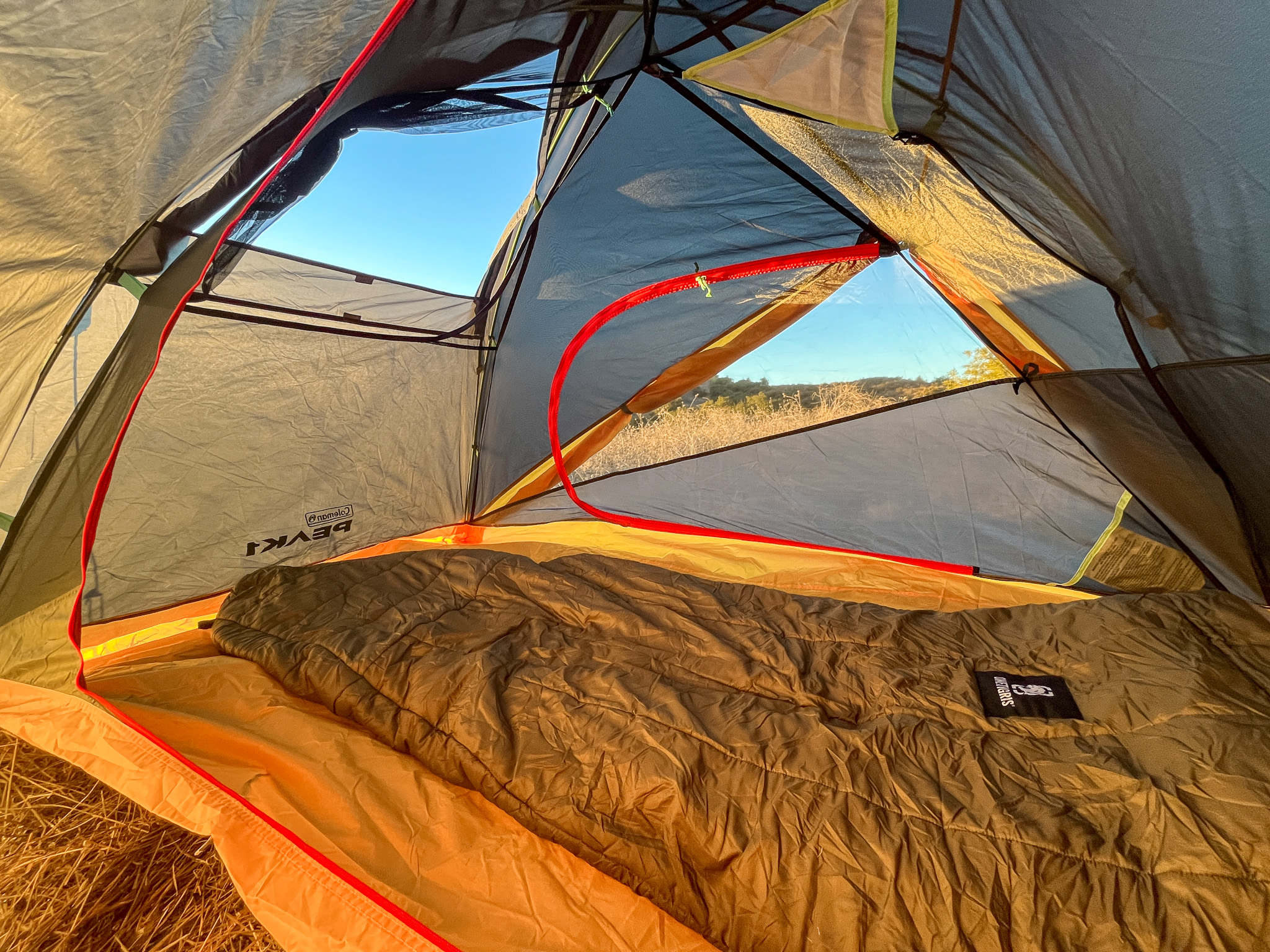
How to Choose a Budget Tent
When considering a budget tent, key factors such as durability, weather resistance, and ease of use will help you find a shelter that enhances your camping experience. Below are some insights to consider.
TENT POLE MATERIAL
When selecting a tent, consider the type of material the poles are made of. Fiberglass poles are budget-friendly, but less durable (and less common), making them susceptible to bending in windy weather. Aluminum poles, while often pricier, offer superior durability, flexibility and lightweight construction. For optimal performance and longevity, especially in windy conditions, prioritize durability over cost.
TENT FABRIC
When selecting a tent, the fabric is a crucial factor influencing its performance and longevity. Polyester, the most prevalent choice, provides a harmonious blend of affordability, durability, and good water resistance. For those prioritizing lightweight material that packs down small and has exceptional water repellency, nylon is a viable option, although it often carries a higher price tag. To optimize durability and water resistance, it’s advisable to opt for a fabric with a substantial denier rating.
TENT SEAM SEALING
To maximize a tent’s water resistance and durability, proper seam sealing is crucial. Factory-sealed seams offer superior protection against moisture penetration, reducing the likelihood of leaks, especially in inclement weather. For tents with unsealed seams, applying a high-quality seam sealant is essential to create a waterproof barrier. However, by investing in a tent with factory-sealed seams, you can be confident knowing that the shelter is well-protected from the elements without having to do it yourself.
VENTILATION
Proper ventilation is crucial for a comfortable camping experience. Mesh panels strategically placed throughout the tent improve airflow, reducing condensation and maintaining a pleasant interior climate. Ventilation vents, particularly those located near the peak or roof, offer additional airflow, especially in warmer conditions. A combination of high and low vents is optimal for maximum ventilation, even with the fly on.
When selecting a tent, prioritize ventilation, especially if you frequently camp in cold and wet environments or humid or hot climates. By ensuring adequate airflow, you can significantly enhance your overall comfort and enjoyment.
WEIGHT
The weight of a tent is a critical factor influencing its portability and durability. Lighter tents are easier to carry, making them ideal for backpacking and minimalist camping. However, they may compromise on features like vestibule space, multiple doors, and overall structural integrity. Conversely, heavier tents, often constructed with stronger materials and larger footprints, offer enhanced durability and spaciousness.
These are better suited for car camping or extended stays as opposed to long-distance backpacking. When selecting a tent, it’s essential to strike a balance between weight and your specific camping needs. Consider factors like the frequency of your trips, the terrain you’ll be traversing, mileage, elevation gain/loss, and the number of people you’ll be camping with.
TENT SIZE & CAPACITY
The ideal tent size depends on your group size, if you’re going solo or not, and your gear storage needs. Smaller tents, while more affordable and lightweight, may feel cramped for some people even if advertised differently. Larger tents offer ample space, but come with increased weight and cost.
Carefully consider your size needs and required gear storage to select a tent that provides a comfortable and functional camping experience. Oftentimes, an advertised 2-person tent can be a roomy 1-person shelter and a 3-person tent could easily become a comfy 2-person shelter.

Conclusion
Choosing the right tent is essential for a comfortable and enjoyable camping experience, whether you’re relaxing in the frontcountry or trekking in the backcountry. With countless options available, finding the perfect balance of adequate features like comfort, weather resistance, durability, and weight can be overwhelming.
However, by investing time in research, you can select a tent that caters to your specific budget, needs, and preferences. Whether you prioritize ultralight backpacking or spacious car camping, our expert guidance will help you make the best informed decision to ensure your next outdoor adventure is a success and your gear lasts a lifetime.
